The Anime Guide to Summer 2015
It’s wintertime! It’s a time for many to take it slow and recollect oneself, relaxing and enjoying the cold weather (or warm, depending on your location). Sometimes, the cold and snow don’t seem particularly appealing, and it’s not a bad idea to sit down and take some time to enjoy indoors entertainment, maybe take some time to reminisce about the warmer days of summer…
While I don’t have a time machine for those of you who wish for something like that, I can offer something that will hopefully squash your boredom and inspire you to spend some time enjoying something you might not have had the time to partake in: anime. This is the comprehensive anime guide to the series that aired in the summer of 2015, a piece that will discuss and introduce close to every series after a season in a comprehensive, mostly spoiler-free, partially impartial guide while still giving my impressions of the series that aired. With so many shows being simultaneously broadcast, it can be a daunting task to enter the world of anime. My hopes are to inform everyone of the general atmosphere of the past season and introduce new viewers to the medium while entertaining veterans and bringing up topics of discussion.
Below the more equitable section will be more subjective analysis where I will mention any series that I thought were significant, whether good or bad. An asterisk by the title of a series denotes additional commentary. If the mild flavor of the first section bores you, feel free to skip ahead. As a disclaimer, nothing mentioned in the first part will do any series justice, as without specific details, there’s only a certain depth to any discussion.
This summer comes after a half-year of extremes, and the anime in the summer lineup enjoyed a level of general amusement that was absent in the previous two seasons. Less anime could be judged as absolutely terrible, but similarly, less anime were thrilling to the very end.
Before I get any further, the following series will not be mentioned because they are insignificant, are for “kids”, have prequels that I have not watched and thus cannot pass fair judgment on, have previous incarnations in different media that I have followed, are some combination of the four, or is Dragon Ball so I must wait for the dub:
Aquarion Logos, Baby Steps 2, Denpa Kyoushi, Dragon Ball Super (Dragon Ball Chou), Junjou Romatica 3, Lupin III – L’avventura Italiana, Ninja Slayer From Animation, Non Non Biyori Repeat, Senki Zesshou Symphogear GX, The iDOLM@STER: Cinderella Girls 2nd Season, To-Love Ru Darkness 2nd, Venus Project – Climax.
Without further ado, let’s get started!
Summer 2015
Table of Contents
- General Insights
1.1 Akagami no Shirayuki-hime (Snow White with the Red Hair)
1.2 Arslan Senki (The Heroic Legend of Arlsan)
1.3 Chaos Dragon: Sekiryuu Sen’eki (Chaos Dragon)
1.4 Charlotte*
1.5 Classroom☆Crisis
1.6 Fate/kaleid liner Prisma Illya 2wei Herz!*
1.7 Gakkou Gurashi!* (SCHOOL-LIVE!)
1.8 GANGSTA.
1.9 Gatchaman Crowds insight*
1.10 Gate: Jieitai Kanochi nite, Kaku Tatakaeri (GATE)
1.11 God Eater
1.12 Himouto! Umaru-chan
1.13 Joukamachi no Dandelion (Castle Town Dandelion)
1.14 Kangoku Gakuen (Prison School)
1.15 Kuusen Madoushi Kouhosei no Kyoukan (Sky Wizards Academy)
1.16 Kyoukai no Rinne
1.17 Monster Musume no Iru Nichijou (Everyday Life with Monster Girls)
1.18 Overlord
1.19 Ranpo Kitan: Game of Laplace
1.20 Rokka no Yuusha (Rokka -Braves of the Six Flowers-)
1.21 Shimoneta to Iu Gainen ga Sonzai Shinai Taikutsu na Sekai (SHIMONETA: A Boring World Where the Concept of Dirty Jokes Doesn’t Exist)
1.22 Sore ga Seiyuu! (Seiyu’s Life)
1.23 Working!!! (Wagnaria!!3) - In-Depth Discussion
2.1 Charlotte: The Mistakes and The Fixes
2.2 Fate/kaleid liner Prisma Illya 2wei Herz!: The Representative Anime of Mahou Shoujo
2.3 Gakkou Gurashi
2.4 Gatchaman Crowds insight: A Philosophical Essay in Animation
2.5 Overlord: Isolation in the Digital Age
1.1 Akagami no Shirayuki-hime (Snow White with the Red Hair)
Synopsis and Summary: In a faraway land resides a girl with beautiful red hair known as Shirayuki (Snow White), beloved by her fellow townspeople as a skilled herbalist and medicine maker. Hearing rumors of her unusual hair color, the lazy and immature Prince Raji wishes to make the girl his concubine and sets off for the far off village. Catching drift of the selfish prince’s departure, Snow White leaves her home, hoping to start a new life elsewhere when she chances upon a strange trio of knights who shelter her from the prince. However, after one of the knights eats a poisoned apple given by Prince Raji, Shirayuki chooses to forfeit her freedom in exchange for the life of her newfound friend. Her knight friend, stubborn even on the brink of death, decides it’s time to actively intervene and save her from an unfortunate fate. Revealing himself to be Prince Zen from a neighboring kingdom, he storms in and takes back the titular damsel in distress, escorting her to his own country where she would forever be safe from the antics of Raji. Akagami no Shirayuki-hime chronicles the adventures of Zen and Shirayuki and their interactions that transforms from a platonic relationship of respect to a blossoming romance.
Akagami no Shurayuki-hime demonstrates the best of a serious shoujo anime. The protagonist is a strong female lead and the character interactions aren’t always cheesy romantic dialogues. Being visually distinct from other stereotypical shoujo is also a bonus. However, be warned that despite its strength in a many categories, its one negative is easily the most important factor in deciding whether or not this series is for you.
The Good: It’s immediately made clear that animation studio Bones continues to put out quality work. The art is solidly drawn and the palette choice fits the tone of the series very well. The animation is smooth and the lighting ensures all the focal points are highlighted appropriately. As previously mentioned, Shirayukihime strays from the typical shoujo style of large, bubbly eyes and excessive background mood tones. If nothing else, the series is great to look at.
As far as the cast goes, the quality of the outside matches the diversity of character on the inside. Shirayuki most prominently treads the path less followed in a genre packed with character stencils and monotony. Intelligent and steadfast, Shirayuki defies most of the qualities associated with shoujo genre protagonists and establishes herself as her own character. While most of the other characters aren’t as distinct, most are still given at least the dignity of a compelling backstory, leading to a well-rounded cast.
The Bad: There’s only one real negative aspect of the series: its plot. Generic at best and sleep-inducing at worst, the story fails to impress even the biggest fans of the series. Nothing pops out, and the narrative is easily forgotten in between episodes due to sheer mediocrity and generality. By itself though, the lack of an immersive story isn’t new and definitely doesn’t determine the fate of a series. It’s the conjunction of such a plot and the pacing that really brings down Shirayuki-hime. Each minute of an episode plods by, and some episodes I struggled to finish before the next one aired. Even the more physically or emotionally intense scenes fail to attract attention.
Who should watch: If you aren’t completely immersed in the relationship between the characters, Akagami no Shirayuki-hime is slow and painful waste of time. Twiddling your thumbs for twenty minutes would be time better spent (source: personal experimentation). However, for those empathetic few that can genuinely appreciate the relationship between the protagonist and the rest of the cast, Akagami no Shirayuki-hime is a delightful and beautiful series to watch.
1.2 Arslan Senki (The Heroic Legend of Arlsan)
Synopsis and Summary: The Pars empire was feared for its military might and had little opposition to its reign. Parsian dominance continued with the reign of King Andragoras and his infamous legions of cavalry. Prince Arslan has grown up in the shadow of his father, and the time has come for his maiden battle against long-time enemies of the kingdom, the Lusitanians. Having destroyed the Lusitanian invaders in recent history, Andragoras ignorantly walks into a trap confident in his victory, leading to the destruction of his military and the capture of the Parsian capitol, Ecbatana. Arslan survives his first battle, but is hunted by Lusitanian soldiers headed by a mysterious man with a silver mask that seems to hold a past grudge against the empire. In his mission to launch a counterattack against the enemy, the prince takes his first steps outside Ecbatana and explores the kingdom. Arslan Senki is the story of a boy’s quest for survival and his acknowledgement of the painful realities of the world.
Arslan Senki is a historical war story based off of a novel series that started in 1986 — that’s nearing 30 years ago now — and remains an ongoing series. Why it only recently caught the eye of the seasonal anime industry is a bit of a mystery, though the 1991 manga adaptation did get two films.
Historical period anime get released fairly frequently, but they seemingly are becoming more popular, with the likes of Yona of the Dawn and Donten ni Warau both enjoying internet popularity. This series particularly reminded me of Yona of the Dawn, if only because the protagonists were unprepared royal heirs with lousy fathers who were unpopular kings that lost control of the throne. Despite these similarities, Arslan Senki doesn’t follow its animated predecessors and wallow in mediocrity. The story is intriguing and well fleshed out, and when combined with the stunning visual aesthetics, Arslan Senki is set up to succeed.
The Good: One of the most interesting things about the universe in this series is its parallel to real history. Pars can be seen as the equivalent to Persia, given the nominal and historical similarities between the two. The Lusitanians allude to crusaders, supported by the fact that the Lusitanians come from a distant land, motivated by faith. Also of significance is the fact that the Lusitanian ruler is Innocentis VII, shadowing the naming of important popes during the crusades, Popes Innocentius II, III, and IV.

There are other cues that tip off the existence of a real-world connection. Parsian cities adopted the typical ancient Arabian style of architecture. As to whether these depictions are accurate, I haven’t the faintest clue, but I’ve definitely watched enough Aladdin to know that buildings in Pars were definitely modeled after an ancient Middle Eastern society. The same could be said of dress code, geographical features, and cultural practices; all of these were meticulously crafted into the fictional universe and gives a fantasy world some sense of reality.
Arslan Senki is arguably the best series this season to utilize narrative well. In a medium that often forgoes narrative in favor of other creative elements, it’s a pleasure to see an anime that embraces a good story above all else. There are battles and fights, with shows of great strength and grand strategies. There is an entire world to see, with more and more unveiled with each episode. There are internal conflicts, characters showing growth and maturity as the series progresses. But by far, the best part of Arslan Senki is the story, and all of the other aspects of the show only serve to make the plot more interesting. The mystique of a foreign fantasy world, the epic military conquests, and hidden relationships of the characters all only exist to make the narrative as interesting as it can be.
The Bad: None of the characters have any inherent flaws; in retrospect, that’s probably the biggest issue. Aside from Arslan, the main antagonist, and a few of the younger members of the cast, none of the characters are very interesting aside from a select few. They may have flaws and insecurities, but the viewers are mostly blind to them. The majority of the ‘main cast’ act more like the support cast for the protagonist. While this in and of itself isn’t a bad thing, it does mean that a there’s a lot of missed potential. In addition, some characters just seem to be thrown away after they serve their purpose, either never to be seen or in the limelight again. All that being said, the characters perform their roles remarkably well, and even if they are flat and static, the chemistry between characters is interesting enough to overlook missed opportunities.
There’s no sugar-coating Arslan’s lack of visual fidelity. The art is decent in low-intensity scenes, but even walking or running seems to drastically lower the quality. Although this isn’t an issue in the first half of the series, the summer season made this problem a noticeable one. The analog animation is stuttery and the CG looks like a lazy attempt to cut corners and save on expenses. However, since it’s only problematic in parts of the second half, the visual elements of Arslan are tolerable and shouldn’t count against it too harshly.
Who Should Watch: This is for everyone, except for those looking for a romantic or humorous story. Though there is a little of both in Arslan Senki, they definitely aren’t prominent features of the series. Binge-watchers and occasional viewers will both be happy; episodes carry into each other, but it’s easy to stop and pick up where you left off as well. Nothing on the production side of things is lacking, and the story is definitely worth a peek at. One of the few must-watches of the season.
1.3 Chaos Dragon: Sekiryuu Sen’eki (Chaos Dragon)
In the year 3015, two empires collide in the battle for supremacy. D’natia and Kōran fight for land, resources, and glory, uncaring and indiscriminate about the victims of the pride-driven feud. The small island nation of Nil Kamui, which had been unaffected by the conflict, has finally been caught in the maelstrom of violence. In a small orphanage in the countryside, Ibuki and his fellows orphans have survived thanks to the influence of Ibuki as the incarnation of the legendary Red Dragon, guardian of Nil Kamui. Despite having immeasurable power, Ibuki refuses to wield it for the sake of violence. However, after foreign soldiers kill Ibuki’s best friend, he unleashes the power of the Red Dragon and vows to protect all he holds dear.
Being the collaborative brainchild of superstars such as Gen Urobuchi (Puella Magi Madoka Magicka), Kinoko Nasu (Fate/Stay Night), and Ryoto Narita (Baccano!, Durarara!!) and employing the talents of both renown and up-and-coming rookie voice actors Marina Inoue (Tengen Toppan Gurren Lagann), Maaya Uchida (Love, Chunibyo, & Other Delusions), Miyuki Sawashito(Sword Art Online II, Fire Emblem: Awakening), and Souma Saitou (Aldnoah.Zero, Akame ga Kill), a lot was expected of Chaos Dragon; however, what resulted was one of the worst series to be released in recent memory.
The Good: One of the best things about Chaos Dragon is the art. It’s nothing noteworthy, but the art is palatable, the backgrounds realistic, and the action scenes are smooth. Note that here, “art” does not cover character design or other visual elements of the series, because those are atrocious.
The Bad: The plot is generic and random, though to be fair, the narrative was conceived from a round of a game similar to Dungeons and Dragons, making random events and details a result of the game, not necessarily a fault in directing. The character designs are arbitrary and incohesive. The CGI is inexplicably terrible. The characters are boring at best and infuriatingly annoying at worst. The music is subpar.
Who should watch: Anime is a decent teaching tool for recognizing visual symbolization, basic and compelling narrative structure, and character development because of the way anime is set up with shorter episodes and quarterly seasons. And with many things, it’s often better to learn what not to do. Chaos Dragon fails so miserably at so many aspects of production that there is no worth in watching it. No one should be watching this.
1.4 Charlotte*
Synopsis and Summary: Yuu Otosaka discovers quite randomly that he has the ability to possess people — for all of five seconds. Though the limitation might be bothersome, Yuu manages to utilize his ability to cheat his way to the top of high school life, finding success academically and socially. However, unwittingly falls into a trap and reveals his powers to Nao Tomori, a mysterious white-haired girl with the power to turn invisible in the eyes of one person. Yuu is told that people with “half-baked” powers like his are numerous and are in constant danger of being abducted by research groups who wish to experiment on them. Hoshinoumi Academy protects these persecuted power-wielders and aims to expand their umbrella of defense to cover all of Japan. Yuu transfers to Hoshinoumi and joins Nao and the rest of the Student Council in his new high school life and in the effort to ensure that all of the special ability holders in Japan find sanctuary.
Charlotte comes from the masters of tears, Jun Maeda and Key, the creators of Clannad, Angel Beats, and Kanon. Partnering with P.A. Works animation studio, the forerunners of the visual novel genre aim to bring another sob story to the screens of anime fans — and largely fail. While many of the artistic elements of production were stellar, the narrative team failed to deliver on the expected inundation of sorrow that visual novel studio Key and writer Jun Maeda are infamous for. However, looking past the lack of a tear-jerking experience lies an enjoyable, if broken and rushed story of a boy and a girl helping others find solace while still searching for their own.
The Good: P.A. Works means quality art and animation. Despite an expansive list of credited anime, P.A. consistently provides excellent visuals that never fail to disappoint. While faithfully sticking to their signature art style all the while exploring subtle differences that cater to an individual series’ atmosphere. The character designs are all memorable (except Yuu, who’s definitely Lelouch from Code Geass), and the animation is fluid and stellar. The visual prowess of P.A. Works is fully capitalized on in the gorgeous opening that masterfully combines so many different aspects of the show with unique and attractive artistic elements, encapsulating the whole experience within a minute and a half. There’s nothing to complain about visually.
The music is also worthy of note; the soundtrack was impressive, and many fawned over the opening theme, citing is as one of the most enjoyable ones this season. Less noticeable but equally significant was the choice of casting; each voice actor did an exceptional job of breathing life into their respective characters. Most notably, Ayane Sakura shows some hidden talent in voicing the tomboyish Nao Tomori, a character trope the actress had never had serious experience with.
The Okay: Unfortunately, without a strong emotional backstory to mask the plot problems, Charlotte shows more clearly than any other Key work the disorganization of the famed studio’s plot structures. Lots of exposition and character development to begin, then compacting the “main” story into the latter half of the season seems to be the never-dying formula. While this ipso facto isn’t necessarily a bad thing, the lack of a powerfully emotional scene means there’s less to distract viewers. On the other hand, the plot itself wasn’t the typical convoluted narrative Key likes to push out and was relatively simple; instead, it rushed and compiled the entire main plot into a few episodes. The story itself is a mishmash of good and bad. While there were many interesting ideas that were hinted at, the writing team flailed around and gave no definitive direction to the show until the last few episodes.
The Bad: Charlotte disappoints the most when dealing with its own characters. While narrative expense primarily deals with the loss of meaningful progression in plot, it second-handedly affects the progression of characters, and this is especially particularly noticeable with Yuu. While on a casual watch, this is very permissible and most likely won’t affect one’s enjoyment of a series, those that pay closer attention to the metastructure of fiction should be warned.
Who should watch: In the end, despite a lot of objective failure, Charlotte is still an anime that will compel you to complete all thirteen episodes. It was an anime I eagerly anticipated week after week, but I unfortunately can’t pinpoint exactly what made it magically appealing. To anyone who’s a fan of slice-of-life with a serious overarching plot and bits of humor and romance, this is definitely one to check out.
1.5 Classroom☆Crisis
Synopsis and Summary: In the far future, humanity has finally managed to inhabit planets away from Earth. In the city of Fourth Tokyo on Mars lives Mizuki Kaito, a prestigious engineer for the revolutionary rocket company, Kirishina Corporation, and a teacher at A-TEC, an developmental class for budding employees of Kirishina Corp. As the future of the technological pioneer for interstellar travel, A-TEC has a huge budget justified by their development of a new rocket engine, the X-2. However, a new student who also happens to be a member of the top brass transfers in and promptly cuts their funding. In a huge financial crisis, the class at A-TEC fight and struggle to finish their magnum opus, learning more about themselves, the company, and the inner workings of a seemingly faultless system.
With a lineup of veteran voice actors and character designs by Ore no Imouto ga Konna ni Kawaii Wake ga Nai (Oreimo)’s character designer and head animator, Hiro Kanzaki, there’s a lot to like about Classroom Crisis to start with… except the actual watching experience itself. While the soundtrack is solid, the voice acting decent, and the art fantastic, Classroom Crisis starts very slowly and is difficult to get into. The pacing is slow and the episodes are forgettable. However, work through the first three or four episodes and the rest will prove to be smooth sailing.
The Good: One can’t mention Classroom Crisis without name-dropping Hiro Kanzaki. His beloved artwork and character design entranced many in Eureka Seven AO and Oreimo, and his lovable style continues in Classroom Crisis. The other visual features of this anime hold up just as well and maintain the level of quality set by the characters. Perhaps more importantly, the backgrounds very much match the style of the characters, and this kind of synchronization is rare. The consistency of the art is an aspect of the anime that can’t be understated.
The Okay: Classroom Crisis, as previously mentioned, starts very slowly. The premise is interesting, but the execution is shoddy and confusing. The lack of any distinguishing features also doesn’t help. This is in part due to the nature of the anime, and it shows later when the plot takes a darker turn. The mysterious origins and motivations of a few star characters really turn the series from unremarkable into something watchable. However, the plot is nothing exceptional and there are a few times when the writing team made some frustrating decisions. Combined with the early pacing issues and the later successes, the ups and downs cancel out to create an overall on par narrative experience.
Who should watch: With the lack of a ‘Bad’ section and very little actual discussion material, it should be obvious by now that Classroom Crisis is a very average anime. Nothing particularly pops out, but nothing creates exceptional drag on the episodic momentum either. For anyone interested in futuristic school life anime that’s not quite as slow as the typical slice-of-life show, this one is for you.
1.6 Fate/kaleid liner Prisma Illya 2wei Herz!*
Summary and Synopsis: Illyasviel Einzbern seems like a normal fifth grade girl. Unbeknownst to all but her closest friends and allies, she gains the powers of a magical girl while wielding the sentient Kaleido Stick named Ruby. Together with her allies and friends, Miyu and Kuro, and her mentors Rin and Luvia, Illya was on a mission to collect all seven class cards, enigmatic artifacts with hazy origins that grant great power to users, when it was discovered that a mysterious eighth card exists. Using the power of the Kaleido Stick, it’s up to Illya and her comrades to defend the world from invaders of another world.
From most perspectives, it would seem the Prisma Illya 2wei Herz! (which will be mentioned as Prisma Illya henceforth) is your stereotypical magical girl anime. Bright, vivid colors; fluffy, girly costume designs; an all girl cast; and strong themes of female friendship and camaraderie all seem to prove so. Prisma Illya is a little deeper than that, if only in thought and theory. With a more serious plot than most other magical girl shows, Prisma Illya shows that the genre can inhabit the middle ground between the Sailor Moon girly and the Madoka Magica macabre. In addition, the art style is unique and well-done, if strange. The OST is decently composed, and there’s a great deal of positive character development.
However, the pacing of the series is close to being unpalatable, and — perhaps the make or break detail — the awkward sexualization of 10-year old girls is a clear cater to otakus that greatly diminishes the accessibility of this series to a broader audience. If you’re willing to look past the (not sexually) explicit scenes, which occur infrequently, then there’s a surprisingly deep and exciting story waiting to be watched.
The Good: From the start, the magical girl offshoot of the Fate franchise has been about the characters, and the latest installment in the series shows no sign of deviating from the formula. Zany and clever insight into a main protagonist only further hyped by a myriad of hints that date back to the first season make Prisma Illya worth a watch. Miyu’s mysterious past is unveiled, and along with it, much of her hidden personality and flow of thought. Most of the supporting characters get backstories of their own, giving every interaction just a touch more color than before.
Speaking of color, the art and animation in Prisma Illya is stellar. The artistic style is acceptable to some and awkward to others, but the action scenes are excellently animated, fluid with no loss in quality, and as colorful as a magical girl battle should be. Even the CG is far less stiff and seems like a genuine solution to some animation issues rather than a mock-up method for cutting costs or looking fancy. The auditory aspect of the series impresses as well as the visuals. The opening theme is catchy and exciting, and the soundtrack follows suit. On the sensory side of things, nothing fails for Prisma Illya.
The Bad: Almost everything about Prisma Illya is great, but the overt sexualization of underage girls is a a big turnoff. While nothing sexually explicit is shown, Prisma Illya takes the ubiquitous yuri undertones found in the magical girl genre and embellishes it until it’s a rather noticeable part of the show; in fact, the soundtrack contains a specific track that’s played whenever something of a sexual nature happens. Though it’s a completely optional part of the viewing experience and can easily be skipped, the fact that producers thought it was okay to portray elementary school girls in such a way is disturbing.
To a lesser extent, the pacing of the show could use some work. Many episodes are mostly fillers, insignificant and irrelevant to the actual progression of the plot until the last few minutes. However, given the length of the source material that the producers worked with, the pacing is justifiable and an acceptable way to deal with the brevity of Prisma Illya. More importantly, the director’s at least ensured that none of the filler time would be a complete waste, making sure that the audience was always learning about the cast.
Who should watch: If you’re uncomfortable with two ten-year old girls sharing a deep kiss with each other in a couple episodes, please avoid Prisma Illya. For those of you willing to brave these uncommon scenes, Prisma Illya is a lively tale of a two kids discovering who they are and who they’re with, saving the world in the meantime.
1.7 Gakkou Gurashi!* (SCHOOL-LIVE!)
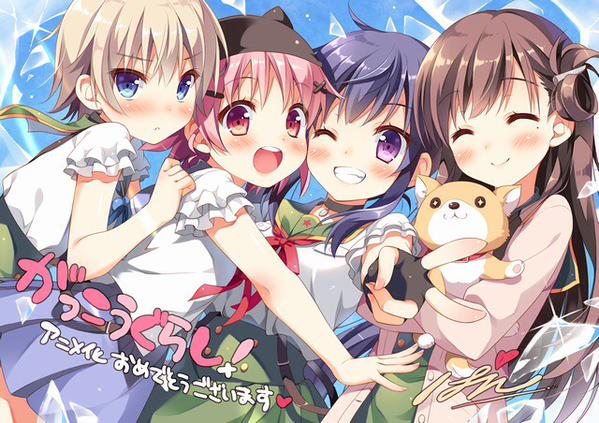
Summary and Synopsis: Takeya Yuki loves her school — so much so that she joins in the School Life Club, a group of people who have decided to live at school. With her three fellow club mates and her beloved teacher, Megu-nee, Yuki enjoys her school life to the fullest, from the tough study sessions to the fun times with friends. Join Yuki and the rest of the School Life club in their blissful, worry-free school lives…
Did that sound boring, plain, and slow? If that’s the case, you should watch this show. To everyone who thought this slice-of-life school comedy was exactly their cup of tea, please stay away. Gakkou Gurashi is an anime whose appearance belies the true nature of the series, and the gimmick they use is unique in every sense of the word. Though there have been other shows who use similar juxtapositions of expectation and reality in order to create an impact, the balance that Gakkou Gurashi found has never been seen before. In order to avoid spoiling it, it’s best to go in blind. A spoiler summary of what was good, bad, and okay will be found in the section below for those that have already watched the show. Otherwise, load up the first episode, keep an open mind, and be sure to make the most out of your school life.
1.8 GANGSTA.
Summary and Synopsis: Ergastulum is a seedy town full of drugs, sex, and violence, ruled by mafia constantly fighting for dominance. What differentiates Ergastulum from other shady cities is the existence of the Twilights, people that possess superhuman physical abilities and are typically employed by the various warring factions. In a place where the police are next to useless, the people rely on The Handymen as a third party to get things done. Worick and his deaf Twilight partner Nic take on any job for the right price, and the requests of their clients often get them involved in the conflicts. After a few suspicious cases, The Handymen realize that a revolution is brewing in Ergastulum. With the tenuous balance of the city at stake, Worick and Nic investigate to catch the person determined to overthrow the status quo of a fragile system.
GANGSTA is exactly what it sounds like — a violent, gritty series that revolves around organized crime and those intricately involved in the system. With a unique setting and amusing characters, GANGSTA shows great promise in the first few episodes. However, it quickly becomes clear that much like violent crime, GANGSTA has no direction.What was originally a small, quirky, tightly knit cast becomes a sprawl of vaguely remembered people with questionable or unknown alliances and personalities. What was at first an anime with an interesting premise becomes an ungainly mess with no purpose. What should have been a show chock-full of action, drama, and mystery becomes a slow grind until it becomes hard to finish an episode and find something that progressed. Much like the fictional city it’s set in, GANGSTA is a story that deteriorates with time.
The Good: There are few things worthy of praise. Ergastulum and its inhabitants are a rare kind of city and people in the anime world. The shadier and more mature type of settings is much appreciated in a realm where the cute and innocent are revered. In addition, the characters are fairly well-developed at the cost of something that will be mentioned later. Each of the main characters have their own tales of origin that deeply affect who they are and how they interact with others. None of these backstories are trivial or cliche either, all of them being compelling tales of trauma and (sometimes) redemption.
Within the same vein, most of the exposition is dealt with smoothly as well. You won’t get long speeches from a single character or narrator that explicitly list everything going on. From small environmental and facial cues to casual conversation, the viewer is spared the Shakespearean-length expositional monologue and is shown the city, not told. Lastly, the sound — or more specifically, the voice acting — is spot-on. Each of the voice actors bring their characters to life, from Worick’s deep and smooth voice to Nina’s shine of innocence and energy in a city of grey death. In addition, Nic’s voice actor apparently perfectly nails the speech characteristics of someone born deaf in the Japanese version.
The Okay: The art was unimpressive. Though the palette choice was appropriate, the quality of the art itself was only decent, and the animation is spotty. At times there would be no issues with the visual aspects of GANGSTA, while at others, it’s clear that the art department is slacking. Stuttery animation and awkward character features are too common to gloss over, though it is worth mentioning that I’ve heard some people familiar with the habits of deaf people say that Nic’s personal tics are fairly accurate, as is the sign language. The art isn’t always bad, but the times when it’s less than acceptable prevents it from being considered any form of good.
The Bad: I mentioned earlier that the main character’s have detailed origin stories at the cost of something, and that something happens to be plot. Did the summary intrigue you? Don’t get your hopes up too high, because the plot progression is abysmal. Whatever airtime GANGSTA had that could have been used for something productive, the producers opted to do nothing. Sometimes, they inserted an anecdotal flashback from Worick and Nic. Other times, it was an ill-placed fight scene. Whatever the substitute, the pacing is interrupted and slowed and viewers get to the end of an episode with almost nothing relevant happening to the characters.
Speaking of characters, beyond the organized and intriguing stories of the three protagonists, nothing is done well. New characters are thrown away as quickly as they’re introduced, and none of the loose ends that come with them are tied up. This applies for the aspects of the story and setting that are established with these new characters. By the end of GANGSTA, the state of the show is comparable to US politics: a lot of problems, a lot of people saying different things, and no one knowing who those people are.
Who should watch: Much like Charlotte, Gangsta, while being objectively a bad series, was still a joy to watch. Finding out the origins of Nic and Worick along with the grittier atmosphere drew me into the world of Ergastulum and made me want more every week. There’s not enough fighting to justify recommending this to an action junky, nor enough mystique to entice a mystery fan. For anyone looking for a change of pace from the everyday anime scene will find Gangsta refreshingly dark.
1.9 Gatchaman Crowds insight*
Summary and Synopsis: After the Berg-Katze incident, the world has largely remained at peace. People have adopted Crowds as a means of community assistance and recreation, and the Gatchaman continue to keep the peace, adding new member Misudachi Tsubasa to their ranks. Currently at war with a terrorist organization abusing Crowds as a vessel of violence, the world is forced to recognize the potential damage that Crowds can inflict on innocent civilians. Around the same time, an alien known as Gelsadra comes to Earth, and the leader of the Gatchaman hails her as a galactic symbol of peace, proclaiming that every planet that Gelsadra has visited achieved global harmony. The Gatchaman are split when it comes to Gelsadra’s methods and intentions, but with the constant outbreaks of Crowds violence incited by terrorists, the world seems eager for the change. With the heroes divided and unexpected consequences of Gelsadra’s plan coming to fruition, the Gatchaman must once again come back and save the world in a way only they can.
Gatchaman Crowds insight can be watched without watching the prequel; nothing of narrative significance is carried over from before. However, it wouldn’t hurt to watch if only to catch up on the characters. In addition, the two go hand in hand philosophically.
You heard right. Gatchaman Crowds insight is one of the few rare anime that you could watch primarily for its pedagogic value. The entire season is structured similarly to an essay, and it shows in the back-and-forth nature of the story. While the plot is intriguing as well, it’s not always the most engaging, a fact that’s aggravated by the one-dimensional cast. The art is basic and simple, and the soundtrack has its highs and lows, averaging to something unremarkable but suitable for the series. The action scenes are rare and unimpressive, save for the final battle.
I’ll be discussing insight below in the analysis section a bit-more in depth because it’d be doing one of the better shows this season a great injustice by only talking about the basics. For any of you that are interested in a series that brings some excitement to a discussion about the ramifications when society that becomes overbearingly communal, the humanity in the need for propaganda, and reasons for thoughtless handover of power to figures of authority, this might be something to enjoy. Anyone looking forward to an action-packed sci-fi series might be mildly disappointed as there are barely any notable fight scenes.
1.10 Gate: Jieitai Kanochi nite, Kaku Tatakaeri (GATE)
Summary and Synopsis: The invaders came on a hot day in August in Ginza, Japan. Humans riding on horses and in chariots fought alongside orcs, goblins, and other fantastical creatures, turning the city into a battlefield. The Japanese Self-Defense Force (JSDF) fought back and forced the intruders to retreat, killing and capturing many of them. Lacking knowledge about the trespassing army, Japan sent the JSDF into the gate where the mysterious group came from to investigate.
Youji Itami was one of the men sent on the mission, and to his surprise, the gate lead to a world reminiscent of the works of fantasy. Magic and inhuman creatures abounded, but the JSDF with their technological superiority crushed any offensive mounted by existing kingdoms. Youji was sent out to forge positive relationships with some of the local villages and gather information, and accrues a new group of friends on his journey. Now well-established in the world beyond the gate, Youji and his comrades face new challenges from the empire, mysterious races of unknown people, and even from other Earth countries.
Gate is special. It doesn’t quite fit into any one genre, but whatever aspects of a genre it borrows, it does well, and that seems to be the main draw of the series. The art quality never stumbles and the soundtrack is great, but neither are memorable or revolutionary. For an anime of its kind, there’s no real downsides to watching Gate. Perhaps the one big flaw is that there’s no grand overarching plot, but it doesn’t pose much of a problem.
The Good: Gate is very hard to define in a genre, but it definitely caught my interest. The initial hook is simple but effective: what would happen if, with our current military technology, we were to face armies of the worlds of J.R.R. Tolkien and other fantasy writers? From there, the series progresses into an adventure, exploring the world beyond the gate and its many people and their cultures. After the adventuring is mostly over, Gate takes on the form of a slice-of-life series. It also takes on the question of how would people from these fantasy worlds react when introduced to modern culture, politics, and civil technology and goods?
The reactions to these questions is what got me started and what kept me watching. There’s a kind of sadistic, hollow pleasure in watching just a few men, with technological and strategic superiority, hold off an army of thousands, a kind of superiority and pride if you will. The transition of genres means there is no clear plot, but in exchange, each mini-arc has clear direction, and as a primarily slice-of-life series, the lack of a serious story isn’t a critical flaw, just a feature of the genre.
Who should watch: There aren’t any glaring flaws from Gate that are significant enough to dissuade anyone from watching. Anyone not interested in the pacing of slice-of-life might find the latter half of this first season to be slower, but for any fans of the genre, Gate is definitely one to put on your list. If you aren’t opposed to slice-of-life, then also consider giving Gate a try; the adventuring and action dissipates once you get into the series, but you might get hooked by the concept by that point.
1.11 God Eater
Summary and Synopsis: It’s 2071, and the world has been ravaged by beasts known as Aragami. Humanity has managed to survive, but the constant threat of these colossal monsters has forced surviving cities to dedicate a large amount of time and research into defense. Aragami can only be harmed by weapons known as God Arcs, swords or guns that manipulate the cells of Aragami. Utsugi Lenka is special: he has the ability to wield a new type of God Arc, one that can switch between its long-ranged and short-ranged forms. With the prowess of his new weapon, he joins one of Japan’s most formidable defense teams in the hopes that he can eradicate the threat to humanity once and for all.
God Eater is an anime adaptation of a game by the same name, and as with many anime adaptations of games, it’s on the worse side of the anime spectrum. The setting is extravagant, but nothing much comes of it. The characters are annoying at best and infuriating at worst, and the story is dull. God Eater’s issues are compounded by a funky, strange art style that’s difficult to get used to and makes for an uncomfortable viewing experience. Overall, it’s best to stay away from God Eater.
The Good: Ironically, the only redeeming feature about God Eater is the art. By itself, the art is fine, great even. The unique textures feel soft and more artsy than the traditional anime techniques, and the color scheme perfectly suits the gritty, post-apocalyptic setting of the series. The character designs are appropriate, making sure that each character looks like they’re supposed to. The backgrounds are well drawn, and more importantly, are consistent with the characters and other artistic elements at the fore.
Unfortunately, it’s the decision to proceed with this art style that creates an odd atmosphere when actually animating. The characters look best when they’re still. The background and static props always look good because they don’t need to be animated. The art gets awkward when animation comes into play, and as a medium whose name is a derivative of animation, it’s not acceptable to have something look bad when animated. Of course, aesthetic appeal is largely subjective, so there might be those who disagree. Make sure to check it out yourself to see how the visuals suit your own tastes. Aside from the uncoordinated mismatch of animation and art style, the animation itself is great. The action scenes are fluid and intense, the camera angles are fitting, and the quality is consistent throughout.
The Bad: Nearly everything else about God Eater isn’t worth any time, but of significance is the pacing. The story moves along so slowly at times that it becomes a chore to finish an episode.
Who should watch: Anyone interested in how anime can and might diverge from it’s mostly standardized visual stylization might find God Eater to be an unusual insight. Action buffs may also consider the sole aesthetic appeal of God Eater to be the only thing they need to enjoy the series.
1.12 Himouto! Umaru-chan
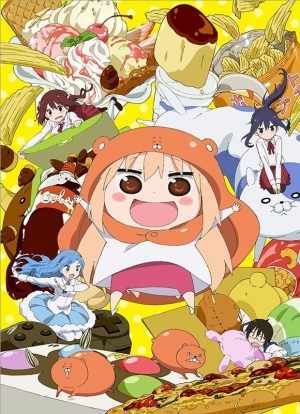
Summary and Synopsis: At school, Doma Umaru is flawless. She’s loved by everyone for being smart, beautiful, and kind-hearted… until she gets home. As soon as she shuts the door of the apartment she and her brother share, she turns into a lazy, short, selfish otaku creature obsessed with games and manga. Himouto! Umaru-chan is a slice-of-life series that follows Umaru as she tries her best to hide her secret from her friends while still maintaining her shut-in lifestyle at home.
One of the more notable slice-of-life series this season, Himouto! was an unexpected surprise. The art style is simple and straightforward and the audio is pleasant. Being a slice-of-life series, there’s no grand storyline, just a series of short adventures, and Himouto! does this well with a cast of memorable characters. At the same time, the show does feel a little lacking. The humor is mediocre and in the end, it was just curiosity that kept me wanting another episode, not the comedy. Himouto! is a new take on the overdone Perfect Student Otaku character archetype, and how the writers decided to expand on that character trope is the major selling point of this anime.
The juxtaposition of “perfect on the outside, lazy otaku on the inside” is cliché, but Himouto! exaggerates the situation to the point that it’s funny again. This was a positive point for me, but how you interpret it will be the deciding factor of whether to keep going or not.
1.13 Joukamachi no Dandelion (Castle Town Dandelion)
Summary and Synopsis: The Sakurada family is the ruling family of the city, and all of the fledgling prince and princesses have been ordered by their father to campaign for their eligibility as the next king or queen. For some of the nine children, this is a chance to grab power. For Sakurada Akane, it’s a living hell. Absolutely mortified at the thought of having to publicly raise her popularity, the shy Akane is constantly living in fear of meeting strangers and appearing on camera — including the security cameras installed throughout the city. Ironically using her fear of being seen in public as motivation, Akane vows to become king in order to get rid of the cameras. Join the Sakurada family as each of them uses their unique powers to start their campaign for the position of king.
Joukamachi no Dandelion is a slice-of-life series through and through, meaning that its pacing is relaxed and its story not very important, or good for that matter. Joukamachi no Dandelion is a middling anime, with some endearing moments and others just pointless. With its decent art and soundtrack and large cast of mixed characters, Joukamachi no Dandelion will capture the hearts of some and leave others in the cold.
I personally enjoyed it very much and looked forward to the weekly adventures with the Sakurada family. As with most slice-of-life series, one’s engagement with the series depends entirely on whether the anime resonates with you or not. For those wondering whether this one is for you, check out the first episode on a streaming site.
1.14 Kangoku Gakuen (Prison School)
Summary and Synopsis: Hachimitsu Private Academy was a top-class school for girls, but starting this year, they have banished their gender restrictions. Fujino Kiyoshi was one of five boys selected for enrollment. Swimming in a sea of girls but too nervous to meet them face-to-face, Kiyoshi is given a lucky break when he accidentally meets with Kurihara Chiyo, a girl with a soft-spot for sumo wrestling. Promising to meet Chiyo for an out of school sumo event, Kiyoshi’s luck seems to have made a complete reversal. But when the five boys get caught peeping in the girls bathroom, the Underground Student Council sentences them time in the prison. Kiyoshi and his comrades accept their punishment, not knowing what dreadful days lie ahead. And being unable to leave the school, will Kiyoshi manage to break free from prison to meet with Chiyo?
Prison School is one of the raunchier anime this season. Physical humor seems to be one of the main emphases of the series, and the directors don’t hesitate to give it freely. The physical humor ranges from the sexual to the gruesome with equal division between the two. However, despite the focus on the physical, Prison School is an exhilarating suspense series akin to Death Note and Terror in Resonance, and the contrast between the ridiculous comedy and the serious situations makes Prison School a darn good watch.
The Good: At first look, it’s evident that Prison School’s art is highly detailed. The characters have realistic features that are drawn exceptionally. The precision of the art carries over into the animation, and though there might not be a lot of running and gunning in this series, what movement is shown is done spectacularly. Interestingly enough, Prison School takes a cinematic approach to camera angles, which resonates well with the realism.
The story is riveting, or more specifically, the way the narrative is delivered is an engrossing experience. Some works of suspense — be they films, comics, or other anime — sometimes stretch time a little too liberally and what should be moments of compelling tension is instead a march of boredom in slow motion. Prison School, being an anime, doesn’t quite have the luxury of time; in fact, if anything, the plot almost seems to jump around a little too quickly. But the episodes in which the suspense is the main focus don’t disappoint. The suspense is further made entertaining by ludicrous situations. As previously mentioned, the comedy in the series is physical, simple, and almost juvenile. Whether or not you agree with this kind of humor is irrelevant because the main purpose of the puerile wit of the show is to augment the experience of suspense.
The Okay: There’s fanservice. A lot of it, and in ways most probably won’t expect. The series never falls away from the sexually suggestive, and certain scenes are definitely not safe for work, or family, or friends. Again, this is mostly used to supplement the scenes of suspense and partly for some fanservice, but the fact remains that it’s there. Whether you like it or not is up to you.
Who should watch: Prison School is best described as an anime that utilizes the sheer absurdity of its humor to emphasize the aspect of anticipation. It’s not smart, it’s not clean. It’s rough and rowdy, and if you can stand or enjoy the stupidity of it all, there’s a great viewing experience to be had.
1.15 Kuusen Madoushi Kouhosei no Kyoukan (Sky Wizards Academy)
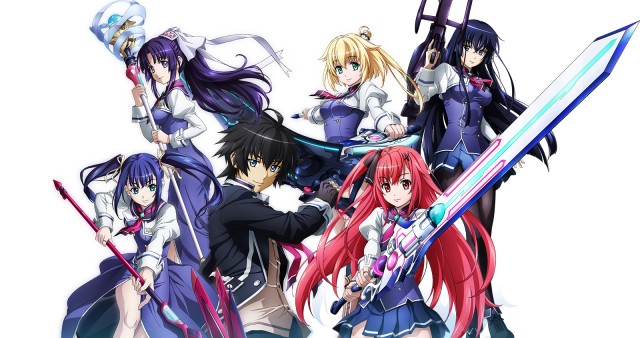
Summary and Synopsis: The world has been decimated by magical flying insects with dense armor and a penchant for destruction. Humanity’s last stand is in the form of wizards who have the offensive capabilities to combat the swarms. One such wizard is Kanata Age, an ace fighter and strongest wizard alive. However, his actions have deemed him the label “traitor,” and Age is treated with contempt by much of society. Age is given the task of teaching three dunces of the Sky Wizards Academy in an effort to get them off the floor and into the world of magical fighting.
Surprisingly, the magical high school setting wasn’t used very frequently this summer, and unfortunately, it’s one representative is a massive failure. Much like Chaos Dragon, there’s absolutely nothing going for this series.
The Bad: The story is nonexistent. The characters are cliché. The setting is overused. The pacing is abysmal. The world is largely unexplored. The art and sound are both mediocre. Objectively, there’s nothing likable about this series. Some series have a few subjective qualities on which the grounds of their enjoyability are debatable; Sky Wizards has none.
Who should watch: Consider skipping this one. Magic high school anime are a dime a dozen, and there are much better series to watch with similar settings.
1.16 Kyoukai no Rinne
Summary and Synopsis: Mamiya Sakura has been able to see spirits since she was young, but because no one else seems to be able to do so, she has kept this ability to herself. One day, she meets Rinne Rokudo, a shinigami of sorts who guides lost spirits to the Wheel of Reincarnation so that they may be reborn and live out their next life. Kyoukai no Rinne follows the adventures of Sakura and Rokudo as the broke shinigami does his best to do the job of an immortal being as a mere human.
From the creator of Inuyasha and Ranma 1/2 comes a new piece, and it’s as out of place in the current lineup as a squirrel would be in a den of tigers. The comparison also works when comparing Kyoukai no Rinne to other shows because Takahashi Rumiko fails to create relatable or interesting characters and an immersive plot. After two masterpieces, Takahashi’s newest work is filled with bland characters, predictable plot twists, boring humor, and art that’s reminiscent of anime 20 years old.
The Good: Nostalgia
Anyone remember the days of Inuyasha? The days of sneaking episodes of Ranma 1/2 because parents didn’t like the PG-13 material? If there’s anything worthwhile about this series, it’s the sense of nostalgia that it induces. Takahashi didn’t discard her old art style, and it shows in every facet of the character design. Unfortunately, some qualities of her distinct style didn’t carry the weight of time as well.
The Bad: Everything (besides the art and sound)
Takahashi’s straight-faced humor style didn’t age well and doesn’t carry over well from manga to anime styles of presentation. The characters are uninteresting. The story is mellow and inane, carrying the Takahashi-esque plot twists from two decades ago. The dialogue is forced and stiff. The narration is intrusive and adds little value to the series. Aside from the art and sound, which are passable, the rest of this anime is sadly not worth investing time into.
Who should watch: For those of you old enough to have actually enjoyed Inuyasha and Ranma 1/2, it’s worth taking a peek at Kyoukai no Rinne, if only to relive the days of simpler times. For those not emotionally invested, there’s no reason to watch a series that’s anachronistic and badly written.
1.17 Monster Musume no Iru Nichijou (Everyday Life with Monster Girls)
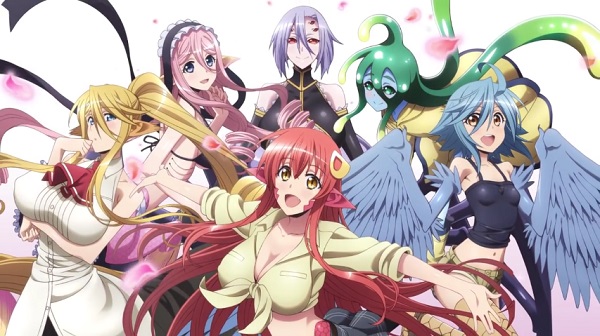
Summary and Synopsis: The world has finally encountered fantasy. Slimes, centaurs, mermaids, and other creatures all exist! But to prevent a complete implosion of modern social structure, these demi-humans are being let in slowly through the Cultural Exchange between Species Act, a law that requires anyone wishing to live in the human world to complete a homestay until they are fully assimilated into society. Kurusu Kimihito is one such person to participate in a program, housing an attractive, lovestruck lamia named Miia. Having one stubborn, obsessive guest is hard enough, but how will Kurusu deal when harpies, centaurs, and more demi-humans are rushed into his home? Caught in the sometimes physically painful crosshairs of love struggles, Kurusu must face the legal, societal, and personal problems that surround the interaction between humans and monsters.
At first glance, Monmusu is just one more instance of “WTF Japan” syndrome. That first glance is completely right. The erotic portrayal of semi-human characters is definitely not normal, and Monmusu is the epitome of the Japanese habit of fetishising bizarre and unnatural things. While certainly, Western cultures do this to a certain extent as well, that’s a discussion for another time. If you’re uncomfortable or just weirded out by the fact that a snake woman wears panties, it’s best to leave right now. However, it’d be unfair to leave out the fact that Monmusu does have its deeper moments. The political and social dangers of being a monster girl in human society is an engaging aspect of the anime that unfortunately isn’t brought up enough.
The Good: The art and animation are both on the higher half of the quality spectrum. Whether or not you think Miia is “undeniably sexy” (as listed on MyAnimeList) is personal preference, but there’s no denying that the art is consistent and looks great. The animation stutters either, making the visual department one of the most successful ones. The sound is also better than expected, with some unexpectedly quality tracks. The opening theme particularly caught my eye with its fast pace and catchy melody.
The Okay: As previously mentioned, the monster girls have to deal with discrimination and exploitation, themes that are brought up from time to time. While other harem type anime touch on these subjects, the context usually leans towards loneliness and not actual social persecution. In this aspect, Monmusu has exponentially more depth than others of its kind. It’s only with the grim reminder of even more fanservice that viewers are brought back to their senses and made to realize that our world — or at least the main consumer group of this anime — only wants sexy snakes and hot harpies and not the problems that come with them. Monmusu still gets points for trying though.
The Bad: Surprisingly, there’s not too much that’s absolutely terrible with Monmusu. There are the typical problems of harem series: lackluster plot, emphasis on the raunchy, not too much real development with characters, pointless protagonist. A lot of these are mitigated with the say Monmusu is structured (13 episodes don’t leave a lot of time for a grand plot, especially in a slice-of-life harem series, etc.), but others are left just as bad (the protagonist is not drawn pupils 99% of the time, showing his lack of relevancy). For its genre, Monmusu scores relatively well. But then again, there are the sexy snakes.
Who should watch: This section should be labelled who shouldn’t watch to make things simpler. Are you uncomfortable with a sexy snake? Are you predisposed to not watch harem anime? Whoever answered yes to one or both of these questions should skip ahead. Otherwise, it wouldn’t be a bad idea to give Monmusu a shot. It’s your typical harem with a few minor upgrades, so anyone who engages in that side of anime should appreciate this.
1.18 Overlord
Summary and Synopsis: Momonga is a terrible creature, a lich king. His imposing skeletal figure emphasizes his horrific magical prowess in the dark arts. With his league of monster comrades and fortress of treasures, Momonga rules the dark side of Yggdrasil with his guild, Ains Ooal Gown… or so one would happen to think. In truth, Momonga is a regular, timid salesman with the appearance of a skeletal monster in a game, Yggdrasil.
Despite the booming popularity of the Virtural MMORPG, the developers have announced that they will be discontinuing support for the servers. Reminiscent of the times he spent with his guild, full of other players with presumably monster-like appearances, Momonga opts to stay for the last few moments of the game alone. However, when the time passes for the servers to shut down, Momonga discovers that he’s not logged off and is unable to log off. More intriguingly, the NPC’s of the world have come to life. Confused, Momonga sets out to explore the new world in hopes of spreading his name and locating any other players that may be facing the same predicament as him.
Overlord is yet another take on the “inescapable game” setting that Sword Art Online brought to mass popularity, albeit with a slight twist: what would you do if you were alone in a virtual world with no escape? With smooth animation and a catchy soundtrack, Overlord is a fantasy adventure that doesn’t fail to deliver the imaginative RPG style setting. However, the central story is a little weak considering the grand scheme that’s supposed to be happening in the background. Also, while there are good things going on with the characters, the directors shamefully let them go into oblivion, making it seem like the crew of Ains Ooal Gown aren’t making much progress.
The Good: Overlord is probably the go-to action series of the summer season. The fighting is relatively gratuitous and well-animated, a combination not seen frequently. This does set it apart from its other “trapped in a VRMMO” setting brethen, which usually skimp on the quantity for an extra-smooth fighting experience or have slow-paced battles that are overall unimpressive to watch. The world building is also well done, and viewers get a firm grasp of the world’s politics and topography fairly quickly.
The Bad: Overlord’s seeming lack of progress is similar to Yuu’s characterization in Charlotte. Anything that happens is quickly tossed under the rug in the next mini-story with a few exceptions such as deaths. This haphazard and inefficient way of delivering narrative means that as a story, Overlord isn’t as strong as it could be.
Who should watch: If you enjoyed Sword Art Online, Is It Okay to Pick Up Girls in a Dungeon, or anything similar, you’re bound to like Overlord. Anyone who enjoys some fantasy action should check out Overlord as well. For anyone that thinks this reeks of cliché and overused tropes, you wouldn’t be completely wrong. Stay clear and you’ll be just fine.
1.19 Ranpo Kitan: Game of Laplace
A teacher has been brutally murdered at school, and the prime suspect seems to be Kobayashi Yoshio, an effeminate middle school boy who happened to be asleep at the scene with a knife in hand. With a strange calmness, he cooperated with the police knowing that he is innocent. During his time with the authorities, Yoshio meets Akechi Kogorou, a genius detective. Bored of everyday life, Yoshio demands to be Kogorou’s assistant, to which Kogorou agrees on a certain condition: Yoshio must catch the perpetrator himself. Behind bars and without any access to the outside world, can Yoshio prove his innocence?
This season wasn’t a great one for mystery fans. Game of Laplace is based on various works from Edogawa Rampo, a Japanese mystery fiction writer whose works pioneered the genre of Japanese mystery. Despite drawing from such a renown source of inspiration, Ranpo Kitan: Game of Laplace fails to do the most important things right. While the art and music are stellar, the actual mystery is executed with the dexterity of a three-year old toddler, that is to say, there is no mystery. There are no clues and there is no skillful handling of information. Rather, Ranpo Kitan: Game of Laplace is a show that draws on the sadistic fetishism of the grotesque and macabre, forfeiting actual mystery in order to show the many bizarre ways people can be killed.
The Good: The few redeeming qualities of Ranpo Kitan include the art and the sound. The art is well-drawn, leaning on the less realistic side of the realism scale (meaning bigger eyes, slightly disproportionate head size, etc.). The most intriguing visual element of Ranpo Kitan is the style of presentation with interesting scene changes and great use of symbolism during monologues. The sound is exceptional as well. As much as a good mystery is about the detective process, proper tracks can help execute the fantasy of enigmatic suspense. The opening and ending themes have also garnered positive reviews, which goes to show that where the writing team failed, the sound and visual teams succeeded.
The Bad: Even a novice in the mystery genre such as myself knows this: a mystery has clues. One cannot solve a puzzle without relevant information, a starting point of any kind. The writers of Ranpo Kitan seem to have forgotten this basic concept, as is evident by the lack of hints and tips. The absence of clues also left behind some collateral damage. Clues are typically one of the primary ways of immersing an audience into a mystery story, giving something that the readers can think about along with the detective. Without the quintessential component of the genre, Ranpo Kitan fails to engage viewers, lowering the tempo of each episode to a slow crawl. Normally, the plot of a mystery anime shouldn’t be judged too harshly against it, as mysteries by default don’t require a greatly detailed narrative to be successful. However, when an effort to include that narrative into the mysteries creates an unnecessary, confusing jumble of information, it has to be pointed out. There’s some sort of greater conspiracy that the writers tried to intertwine with the episodal cases, and it just doesn’t work.
Who should watch: As the main appeal of Ranpo Kitan is mystery, something that the show completely neglects, I cannot recommend this to anyone.
1.20 Rokka no Yuusha (Rokka -Braves of the Six Flowers-)
Summary and Synopsis: Long ago, a being known as the Majin terrorized the land. Sending forth his army of demonic creatures, humans were slaughtered indiscriminately and were on the brink of extinction — until the Six Braves appeared. Armed with superhuman powers, the six braves repelled the invading army until they cornered the Majin on a peninsula to the west. Unable to completely defeat him, the Braves opted to seal his presence as a temporary means of eradicating the threat to humanity. The God of Fate now carries on their will and selects six new braves every generation to deal with the pending doom that will be unleashed when the seal of the Majin is undone.
Adlet Meyer, self-proclaimed strongest man in the world, is chosen as one of the six, and with sudden influx of demon soldiers indicating the Majin’s return, it’s time for the six Braves to come together once more. But caught in a sly trap, the Braves meet and discover that there are seven of them. Adlet as the most suspicious is immediately deemed to be a spy. Adlet must use all his cunning and wit to prove his innocence and find the real seventh Brave.
Rokka no Yuusha started with a lot of promise: an Incan/Mayan based fantasy world; an eclectic cast of starting characters; beautiful art and stellar animation; CGI that didn’t feel plastic; a grand premise that starts the whole adventure; an element of suspense to start the mystery. Popular opinion tells me otherwise, but I can’t affirm the sentiment that Rokka is a good anime. The quality of the art is inconsistent, the mystery isn’t enticing nor is it well-executed, and there’s not enough action to redeem Rokka as an action series.
The Good: Rokka’s best characteristic is its ability to keep the audience invested in some of the characters. Adlet’s self-confident demeanor isn’t just fulfilling a character stereotype. His personality is a result of everything that he had experienced up to the point of events in the story. The way certain characters interact with Adlet is also enjoyable, and the slowly blossoming romance between a specific pair of individuals was also well-developed and a pleasure to see. That being said, not all characters are as well fleshed out. Some are completely disregarded, and this particularly proves to be a heavy burden when it comes to the mystery aspect of the series.
The Okay: The art is fantastic… mostly. The character designs are cohesive and memorable, the style is fitting and likable, and the animation is smooth. I particularly liked the Mayan influenced architecture of the world, an source of artistic inspiration not often seen in anime. The issue is, of course, the fact that the artwork doesn’t always hold up. The characters are sometimes drawn awkwardly and any movement looks artificial during these instances. These visual inconsistencies appear frequently enough that it’s easy for someone not paying close attention to notice.
The Bad: It’s not wise to set up a series to be a fantasy action adventure then swap over to mystery. Sure, it’s doable and it might make for an interesting setting, but splitting interests doesn’t always work out, especially considering how time-demanding it is to pull off a good mystery and adventure. This isn’t enough to count Rokka out though; it sets things up decently well and the series starts with a success not many others see. Still, it was surprising to see a grand adventure to destroy the Demon King transform into an 8-episode game of Mafia. This by itself, as mentioned, is fine — if it were good. The puzzle isn’t compelling, and it’s almost boring at times. The lack of fulfilling characters seriously undermines the legitimacy of Rokka’s mystery, and though some may argue that there’s enough characterization to pull a decent romance out of the series, it takes more than two good characters to create a mystery about seven people.
Who should watch: Going into this with the mindset of enjoying a sophisticated mystery would make the beginning drawn out and boring, and keeping the perspective that Rokka is a fantasy adventure would betray your expectations in a bad way. Mystery fans may enjoy this one, but it’s not on par with other mystery series released in past seasons.
1.21 Shimoneta to Iu Gainen ga Sonzai Shinai Taikutsu na Sekai (SHIMONETA: A Boring World Where the Concept of Dirty Jokes Doesn’t Exist)
Summary and Synopsis: In the future, Japan stands as a stronghold of morality with among the lowest rates of sexually immoral behavior in the world. In an effort to maintain their position, the Japanese federal government now monitors the words and actions of its population, ensuring that any sexually explicit movements or words are punished as crimes. As a son of a perverted terrorist, Okuma Tanukichi seeks distance himself with his father’s legacy and uphold the new standards of cleanliness as a model citizen. However, on the way to his first day as a high school student, a terrorist by the name of Blue Snow from the terrorist group SOX strikes at a train station. Later at school, he’s recruited into the student council, only to find out that the vice-president is Blue Snow herself. Coerced into join SOX, Okuma finds himself in the crossfire over the war on dirty jokes.
Shimoneta was a strange one. From the production standpoint, Shimoneta is fairly standard. The music works, the art is consistent, and the animation is never broken. What makes Shimoneta hard to judge is that all of its merits and its downfalls are purely based on the subjective aspect. In the first episode, it’s hard to dislike the series; it’s so outrageous with it’s pervy humor that one can’t help but laugh. From there, it’s all down to personal preference.
The Okay: The humor is undoubtedly novel in the beginning. Uncomfortable? Possibly. Inconceivable that something like this would air on TV? Yes. But as the show goes on, the intensity of the humor — or perhaps one’s perception of it — diminishes and so does its impact. The story isn’t worth watching. The characters aren’t very special and the anime makes no moves to appease those who want to complain. Ultimately, what will keep one watching Shimoneta will be for the humor. To some, the gags will get stale, and at that point, the show can and should be dropped. To others, every episode will bring about a laugh. And to the few who don’t belong in either category, the curiosity to know what comes next in the lives of the lewd terrorists will urge them to continue.
Who should watch: Everyone should watch the first episode. It’s unique, and if you’re not too uncomfortable with some sexually-geared humor, it’ll be worth the twenty minute investment. It should be noted that its sexual humor from the perspective of a middle schooler. If there’s some immaturity left inside you, give the first few episodes a try. From there, anyone who thinks the comedy is losing effect can safely discontinue their viewing experience.
1.22 Sore ga Seiyuu! (Seiyu’s Life)
Ichinose Futaba has just started working as a seiyuu — a voice actress. Join Futaba with her fellow debuting voice actress Moesaki Ichigo and seasoned industry pro Kohana Rin as they go around doing what voice actors do.
Have you ever wondered about the lives of the voices behind your favorite anime characters? Sore ga Seiyuu! is a delightful insight into the people who work to bring characters to life. Unlike its other brethen that explore the Japanese exclusive forms of media (Bakuman, Shirobako), Sore ga Seiyuu! focuses on informing rather than on entertaining. Enjoying this series solely depends on how interested one is in the subject matter. Because of that, there’s not much else to say here. The art is on the cutesy side but is overall easy on the eyes. The music is nothing spectacular. Think of this as a light-hearted, animated documentary, and for those of you to whom this sounds appealing, Sore ga Seiyuu! will be your pick of the season.
1.23 Working!!! (Wagnaria!!3)
Summary and Synopsis: The crew of the Wagnaria family restaurant are at it again. Join the cast of quirky characters as they endeavor through mishaps with work, family, friends, and love.
Working has been a bigger name in slice-of-life circles since its first season, and the third season continues its tradition of aesthetic and musical quality. The third season is another step up from the previous ones though because it ties up some of the major plot points observed throughout the series thus far.
The Good: Will Otoo-san ever meet his wife again? What will become of the relationship between Satou and Todoroki? Where is Yamada’s real family? These are all questions that have been running through viewers’ minds since these issues were brought up, and season three is finally giving closure to all of them. Season two, even with all of its fancy upgrades, was slightly frustrating to watch because these problems were brought up time and time again but never resolved. Directors teased at finality but never delivered. Instead, we get a season dedicated to sealing the deal on the big points of interest, and it’s gratifying and refreshing.
The Okay: The humor after three seasons of wear and tear can get a little stale. While Working does find new ways to amuse the audience, it’s not a huge departure from what’s already been done before, so it’s understandable that some might find the comedy to be lacking. It’s not a huge deal in this season as the humor isn’t really the point of interest; it’s the aforementioned closure of the plot. And at this point, each character’s quirks are a part of them, not brought out to extract laughs and giggles but as a natural part of their method of human interaction.
The new opening sequence and theme song reek of mediocrity. The quality of both aren’t too different than previous incarnations; however, both are just middling and don’t contain the fun, subtle things that made the opening fun to watch in the past. The interactive animation is gone: whereas in the past, characters would “sing along” with the OP, the third season has gotten rid of that particular part of animation. Accordingly, the style of the opening theme doesn’t quite have the same appeal either, since the animation and music aren’t synced on the same level they were previously.
Who should watch: Slice-of-life series make this section simple. Do you enjoy watching a series with nothing significant going in terms of actions, speech, and ideology? Then watch Wagnaria. It’s a laid-back and relaxing series, and anyone with some time on their hands wanting to avoid the grandeur and excitement of life and other anime should give Wagnaria a try. Do start from season one if you’re new to the franchise though; you’ll miss out on the reasoning behind a lot of things by starting from season one.
And that’s all folks!
Thank you for reading through this guide. I hope you left with a small interest in watching any of the series mentioned. Anime occasionally has uncovered gems, but what may be just a sparkling rock to some may be a shining diamond to you. Hopefully, this guide will lead you to one of those personal treasures by sifting through and organizing all those potential sparkling rocks. If you have any questions, comments, or complaints about the format, feel free to leave a statement or inquiry in the comments section. Below here is the section where I dissect a few series to much greater depth that require me to reveal important events in an anime. If you’ve already watch all of the asterisked series, head on down and join the discussion. If you don’t mind spoilers, there simple, not very coherent summaries scattered throughout a series’ respective section, so feel free to analyze with no prior knowledge. Otherwise, come back after you’ve watched them and partake in the analysis then. Enjoy your anime!
In-depth Discussion
2.1 Charlotte: The Mistakes and the Solutions
Charlotte was interesting. While, objectively speaking, it should have been difficult to enjoy the show, I found myself looking forward to each new episode. Charlotte was one of the easiest anime to continue watching despite lacking key elements or outright failing to address critical issues that plagued previous works by the same creators.
Speaking of the issues, it’d be wise to go a little more in-depth because there’s only so many negative things one can say without absolutely determining a reader’s judgment of a show. Nothing said above fully encapsulates everything wrong with the show, and Charlotte had more than a fair share of problems. In sum, Charlotte copied a lot of what Angel Beats did incorrectly without also incorporating the factors that made the latter a success.
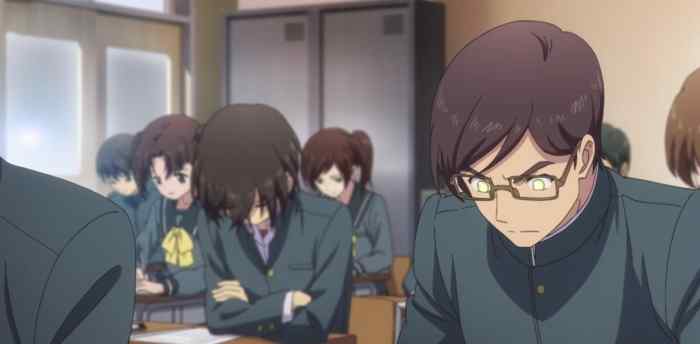
Charlotte looked promising, and it started off fantastically. The main character, Otosaka Yuu, is just a normal person. He’s not an upright hero who dedicates his powers to helping others, nor is he a villain to his core, doing evil for the sake of evil. Rather, Yuu is the typical teenager given the power of possession, and he does what a normal teenager would do. As he progresses down the path of “evil,” we see him stopped in his tracks by the straightforward, headstrong Nao and her honest henchmen, Jouji. The characters are likable and have amusing internal chemistry, the premise of the series was solidly explained in the first three episodes without being overtly expositional, and more than anything, it was plain interesting.
One thing Charlotte failed to do was give a firm direction to the series early in. Starting with “character of the day” episodes then switching to a more serious arc is an okay idea if the entire run of a series is 25 episodes. But in a single cour, 13 episodes, there’s just too little air time to have the level of commitment in every aspect of the story. Charlotte wanted to have great character development with an engaging, a majestic and moving plot, and emotional catharsis so strong it leaves the screen and leaves a real, tangible impact on the viewers. It didn’t happen.
Relatable and likable characters; an immersive story; a strong emotional message — these are all major aspects of good fiction, and yet none of them happened. As previously mentioned, it’s impossible to give Charlotte a passing grade. The core of the problem lies in the downright terrible pacing that the writing team somehow thought was a good idea. Investing half the season into character development is a worthwhile endeavor if the focus is on the characters. Forfeiting the opportunity to deepen the characters in favor of advancing the plot and creating plot hooks is great if the focus is on narrative. Not that it’s impossible to do both at once, but in attempting to develop everything, one runs the risk of writing something that touches on everything but leaves when everything is still shallow.
It was entirely possible for Key to have the best of everything, but they ceded everything they had for no reason, and this is the true reason that on an objective level, Charlotte is a bad anime. Key refused to capitalize on what little they had gained and instead yielded the chance in order to work on something else. Take, for instance, the entire scene with Yuu and his sister’s death. What should have been the emotional turnaround point with Yuu losing his only known family member at the hands of a jealous middle schooler ends up being a simple time skip when Yuu blacks out and reawakens at a hospital bed to be told that his sister has passed away.
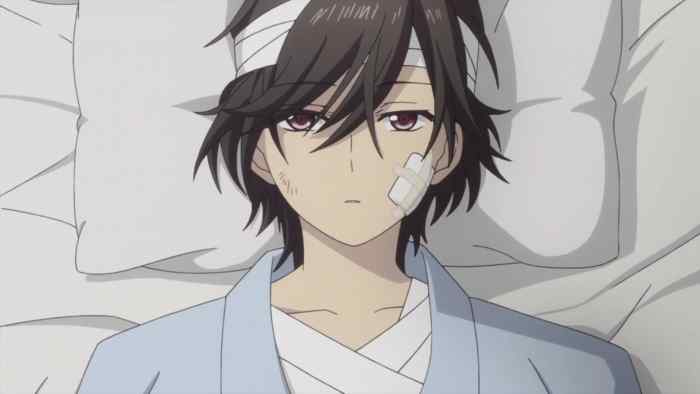
This might have been slightly better if there were any signs of realistic emotional backlash afterwards. Instead, Yuu plays hooky, turns his back on his friends, uses his powers for violence, and nearly does heroin when he’s met with a punch to the face and some words about friendship. From there, it’s almost as if his sister never died. Sure, it’s the premise for the plot for the rest of the season, but Yuu almost never shows any more emotion over the fact that his only living relative is now gone.
The aforementioned situation is a gross materialization of something that happens throughout the series. Yuu, much like tofu, always seems to come back as a neutral, flexible character that adapts to the situation required for him. This sounds like a good thing; unfortunately, it’s not. It means that any way the story decides to shape him ends up being useless, because by the next episode, he’s back to a neutral state, ready to approach the situation in whatever way Maeda sees fit.
This is most evident in the complete loss of his devilish teenager personality. The boy who used 5 second possession as a means of cheating his way to the top disappears by episode four. Besides random moments when he comments on the actions of his former self, it’s as if those days never happened. The boomerang affect of Yuu returning to a neutral state is also clearly shown in the Yuu-Ayumi development. And it happens again and again. This kind of waste of what businessmen call emotional capital and the regression of character development is unforgivable, especially since an emotional response is what Maeda is always aiming for.
On the plot side, things look just as bad. Until episode 8, there’s no clear path that Charlotte treads. The character-focused structure of the first six or so episodes seems to hint at a more slice-of-life oriented series, but that’s quickly overturned by the tragic events with Yuu and his sister Ayumi. The rest of the grand adventures of Yuu are wrapped up in a mere six episodes, two of them dedicated to setting the stage. For a whopping total of four whole episodes, we the audience are treated to Yuu’s true mission in the series. And then comes the best part of the entire anime.
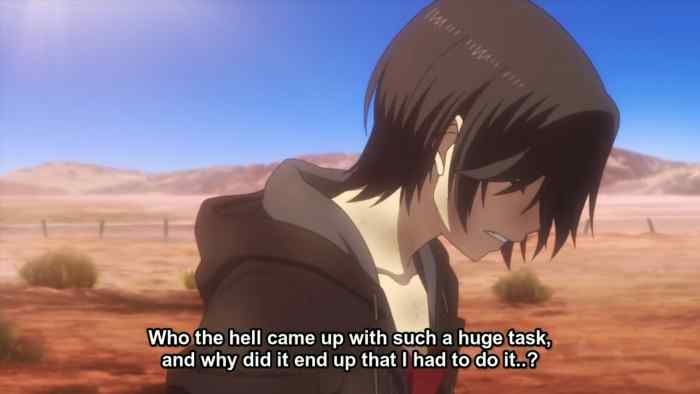
The first 20 minutes of the last episode of Charlotte is “objectively” the best part of the show. Yuu takes on the daunting task of plundering every single ability on the planet, and the episode chronicles his slow descent into mental and emotional instability as he acts as the ultimate vessel, taking in thousands of special powers. He begins to lose his memories and forgets his purpose. And when he finally manages to extract the last ability, he collapses and seems to be on the brink of death. Here is where Key clearly is at a loss because they take deus ex machina too seriously: a helicopter, a literal machine, descends from the sky with Yuu’s brother and his crew on board. Talk about deus ex machina, this is as close as it gets to the phrase’s true meaning. Everything was going so well — the best twenty minutes of the series — and Key decides to use a cheap plot device to ruin everything they’ve set up. There is no ending impact, and nothing to show for the previous twenty minutes of Yuu’s mental agony.
It’s clear that the production team should have went back and reworked a many things, but there are specific aspects of the story that could have somewhat saved the series. One such thing is exploring Nao’s personal life. The audience is treated to a glimpse of her suffering when a group of girls gang up on her to deal some physical justice. It’s never clearly mentioned why she’s enduring the bullying or, for that matter, why the bullying is happening in the first place. All we’re told is that “it makes sense because of her powers”. Nao’s clearly supposed to be a central figure of the story, but there’s no love given her way. Some uncovering of her motives and personality away from her brother and student council business would have eased many of the character issues Charlotte faces.
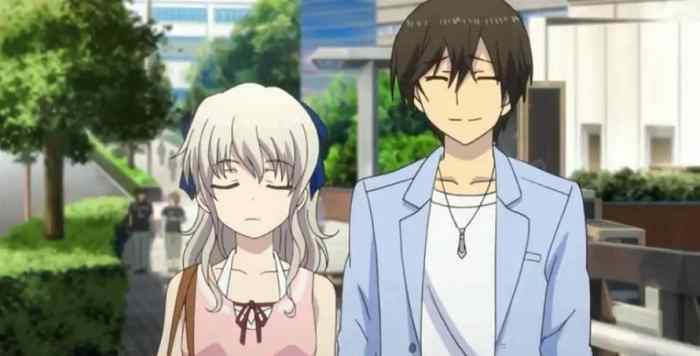
Another solution to some of the problems in Charlotte would be an epilogue episode, or even a whole sequel series. What’s passed can’t be changed, but adding on to the series could retroactively clear away some of the previous conundrums. Explore the newly growing relationship between Nao and Yuu. How does Yuu deal with harboring thousands of abilities in his one body? Is his memory loss going to be a perpetual problem? How does his personality deal with mental and health issues going forward? And more importantly, how would all of this affect Nao? Would she be as patient, or maybe outwardly apathetic, as she was with her brother? Will the pain of having to deal with two losses of people important to her drive her mental state up the wall? And in turn, how would Yuu react to Nao’s reaction? Will it be Clannad style coping with depression, complete with alcoholism and gambling? Or would Jun Maeda try something new, maybe a renewed Yuu forcing himself to remain sane for Nao’s sake? All of these are questions that could drive the plot of a sequel or an epilogue, and all of these would remedy what little characterization there was in the main series.
2.2 Fate kaleid/liner Prisma Illya 2wei Herz!: The Representative Anime of Modern Mahou Shoujo
There’s a lot that could be said about this series, but I’m going to converge them all into one point: Fate kalied/liner Prisma Illya as a series embodies what makes up the modern mahou shoujo experience. While the series abandoned its meta-commentary early on, the amalgamation of characters, plot points, and themes are a perfect middle ground for what constitutes the magical girl genre and its fanbase.
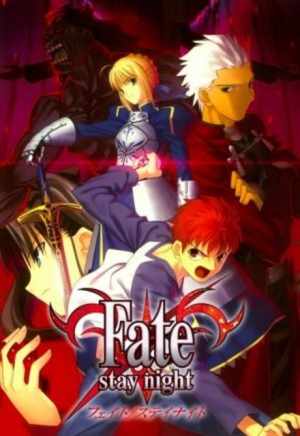
Starting with the basics, mahou shoujo is one of the most monopolized genres in anime. This might partly be due to the fact that the market for magical girls is (publicly) small, but a few big names dominate the shelves of the virtual library: Sailor Moon, Pretty Cure, Lyrical Nanoha. These are big franchises with immense popularity and many many episodes. What few other magical girl anime do air are either quickly forgotten or simply outclassed — with a few exceptions. Linking this point of “big name monopoly” back to Fate kaleid/liner Prisma Illya, we see the connection. Prisma Illya is based off a big name series itself, Fate stay/night.
I mentioned that there were a few exceptions to the monopoly rule, and one of those exceptions is Puella Magi Madoka Magica. An unusually dark and gruesome series for a mahou shoujo anime, Madoka Magica did what Gundam did for mechas — that is, prove that a genre could be more than juvenile flights of fantasy and can enter the world of the gruesome and gritty, the world of adults. Since the air of Madoka Magica, mahou shoujo has taken a turn for the darker, with even Lyrical Nanoha occasionally opening up to its darker side. While Prisma Illya isn’t on the level of Madoka Magica, the story is pretty darn serious and definitely doesn’t tone down the serious moments. More importantly though, Prisma Illya doesn’t forfeit the traditional elements of mahou shoujo. Feminine friendship, frilly outfits, and slow slice-of-life scenes all play an important role in what many people assume to be the essential mahou shoujo experience, and all are present in Prisma Illya. That isn’t to say Madoka Magica doesn’t have these, but definitely the latter lacks the emphasis on some of those aspects.
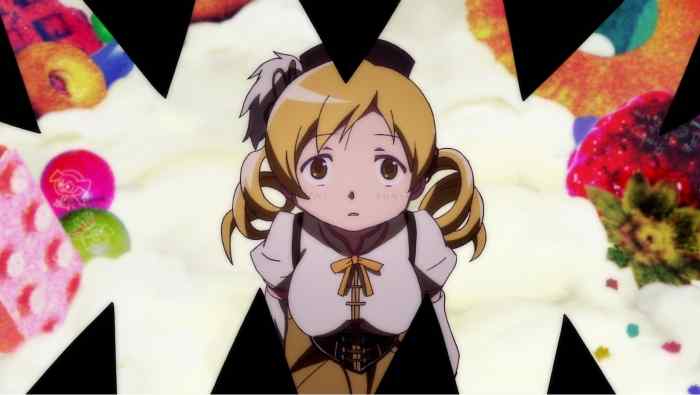
Speaking of feminine friendship, that’s one facet of mahou shoujo that Prisma Illya expands on and embellishes because it’s such a large part of the fan experience. Yuri undertones are prevalent in every magical girl series, and the fanbase is excellent at picking up on these signals and producing massive amounts of fan content on the girl-on-girl love (sexually explicit or not). Keep in mind that these yuri undertones are just that — undertones. No series directly acknowledges the actions of its fanbase, but the directors and writers of Prisma Illya knows its crowd and aims to please by including the sexualization of ten-year olds. No charts or polls will ever accurately tell the number of mahou shoujo fans. The accuracy would drop even further when looking for a statistic ennumerating the people who admit to enjoying the sexualization of ten-year olds. And as criminal of an act as that sounds, enough people enjoy it or put up with it enough to continue watching the series. Three seasons with a fourth planned is a great run, and there’s no signs of Prisma Illya stopping. As unpleasant as it may be to some, Prisma Illya is merely a manifestation of the activities of mahou shoujo fans. And personally, the fanservice is infrequent enough to tolerate. It’s also important to remember that Prisma Illya is a work of fiction: no ten-year old girls were harmed in the making of this series.
2.3 Gakkou Gurashi (SCHOOL-LIVE)
As previously mentioned, I’d like to discuss what was good, okay, and bad about the series down here.
The Good: The plot hook was phenomenally done. I assumed this was just a random, cutesy slice-of-life series and hung until the last few minutes of the first episode, and promptly forgot about it. After seven weeks into the season and hearing fantastical things like “Gakkou Gurashi is my favorite series this season” several times throughout the course of those seven weeks, I steeled myself and started episode one again — and was treated with one of the biggest shocks in anime. The juxtaposition of cute and gruesome was a startling contrast, and I spent the next couple hours engrossed in the series. And from a casual standpoint, the premise of the series is very interesting. A girl traumatized by the untimely and macabre death of a loved one in the face of a global crisis masks her present with her imagined utopia of school life. If that isn’t a unique premise, I’m not sure what would be. And yet, while the premise is nice, a more detailed look reveals that once the shock factor lifts, there’s not too much beneath the surface.
The Okay: The novelty of Gakkou Gurashi is its biggest strength, but also acts as a major component of one of its big weaknesses. While the grisly zombies and cute art style does bring about a nice contrast, it also makes the solemn parts of the series hard to take seriously. Emotions of terror and panic are hard to empathize with when the characters looks like they’re six years old. While the situation and palette choices do help with certain scenes, if the situation isn’t dire, it was hard to feel the urgency that other anime with a similar theme but with seriousness embedded from the get-go can instill. The constant switching between Yuki’s perspective of a fun-filled school life to the reality of a zombie apocalpyse didn’t help either.
The plot was also pretty messy, and major plotholes are left uncovered. A large part of this is tied in with the characterization, particularly surrounding Yuki. Other frustrating things happen with other character’s, but mainly Yuki as the main protagonist is left deeply unexplored and her mental condition left unexplained. While normally these are pretty significant things, I listed them under being just okay for the same reason it’s poor taste to criticize a slice-of-life series for not having a good plot: it’s not the point. The focus of Gakkou Gurashi is the novelty of the shock of girls attending school contrasted with a zombie apocalypse. Sure, having deep characters and a more cohesive plot would be of great benefit, but not having these things shouldn’t take away too many points.
2.4 Gatchaman Crowds insight: A Philosophical Essay in Animation
Thought the art was passable, the CG awkward, the narrative strait-laced, and characters shallow and unexplored, much of the fan base had mixed to positive reviews of the first season of Gatchaman Crowds. The make-or-break factor? While Crowds‘ primary plot was spotty and didn’t provide much on an expository level, it was its secondary, ideological narrative that justified its unexpected popularity. In an era in which a large portion of the interaction between people are done behind a screen, on what part of the human spectrum do hate and anarchy lie? Are they truly conscious, evil desires to destroy or something more innately and intimately human? To a lesser degree, Crowds questioned the value of individualism in a homogeneous, global community and the impact of media on the balance between communal values and individualism.
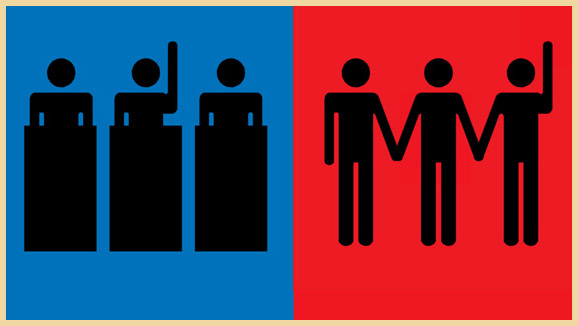
In insight, the conundrum is reversed: what are the ramifications when society becomes overbearingly communal? While unity and harmony are ideals to pursue, what does the absence of individualism spell for politics, culture, and society in general? What causes a complete loss of individual will? And most importantly, how do the ideas and propagation of information affect the individual in an era of the internet and mass media dominance of the information sector? Watching the series, the answers are clear but, at the same time, a bit complex. Here, I just want to introduce the story and briefly touch on some of the core topics of discussion that Gatchaman Crowds insight develop.
The relevant story begins with the introduction of Gelsadra, the intergalactic bringer of peace and harmony. However, from the minute Gelsadra is introduced, Berg-Katze offhandedly makes an ominous statement that Gelsadra scares him, the harbinger of anarchy and chaos, forewarning that what the newcomer does is far worse than indiscriminate destruction.
With massive help from media, the alien celebrity manages to win over Japan’s troubled population to claim the post of Prime Minister. After displaying his decisive and acute political acumen, Gelsadra sets himself up as a proficient, caring unifier of the people, for the people. Everyone loves her ability to make the best decision by taking in the citizen’s thoughts and emotions. Yet, despite Gelsadra’s powers, he never understands why he can never seem to reach 100% approval on any of her policy reforms.
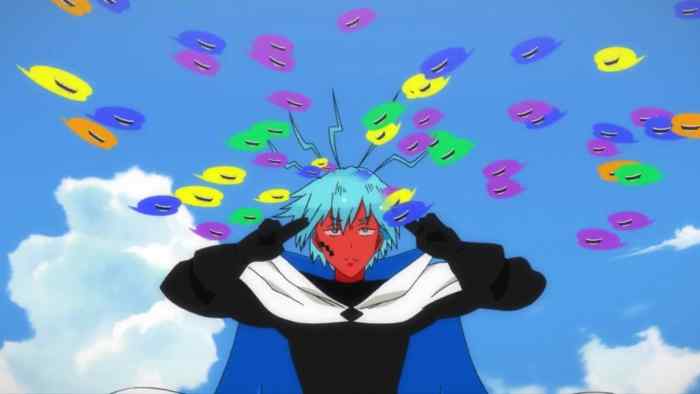
To remedy this, Gelsadra introduces a new option in the smartphone polls: leave it to Gelsadra. When allowing the public to vote, they now have the option of letting Gelsadra make the best judgment directly on their behalf. At first glance, this seems to make a lot of sense. Gelsadra has the useful ability of large-scale data collection and processing, giving her an insight that no one else can hope to match. Yet even this method fails to produce the unity that Gelsadra is aiming for, despite the newly introduced option rapidly gaining popularity.
In the end, Gelsadra overuses her emotion reading abilities and regurgitates some of the thoughts he’s absorbed. In a strange twist of science fiction, these thoughts and emotions incarnate themselves into the Kuu-sama, strange beings that weirdly seem to understand everyone’s emotional state and can adapt their words and actions to most comfortably suit their surroundings. The Kuu-sama are an immediate hit with the general population, and almost everyone enjoys hanging out with them. Unification of the human populace seems to be at hand… until the first incident happens.
Ichinose Hajime is the first to realize that the Kuu-sama are physical manifestations of the atmosphere. Not the physical atmosphere that composed of nitrogen, oxygen, and various other gases, but the mental atmosphere that’s created by the general emotional state in a gathering of people. Anyone whose personal feelings are opposed to the the emotional atmosphere they are in are literally swallowed up by the atmosphere, eaten by the Kuu-sama. Gelsadra approves of this: accepting that there will always be a small minority that will always exist and always oppose the majority, the most efficient way of achieving unity must be to eliminate the minority. The rest of the series consists of the Gatchaman wrapping up the whole issues neatly with the help of the infinitely wise Hajime.
Critiques of Individualism
Japan is initially at “peace”, though involved in a de facto conflict with the terrorist organization known as VAPE. VAPE aims to demonstrate when individuals are granted too much power, utilizing the functions of CROWDS to frighten citizens and cause general mayhem. Rizumu Suzuki, the founder of the radical extremist group, goes as far as to call a majority of the human population as apes, though at this point in time, the reasons for doing so aren’t as clear as they become. Though the group is quickly shut down and its leader incarcerated, the effects of their actions linger among the general population and on the creator of CROWDS himself, Ninomiya Rui. People begin to question whether CROWDS can truly benefit humanity if the potential dangers of misuse are so dangerous. VAPE highlights the worse end of individualism, a state of society in which individual freedom leads to anarchy.
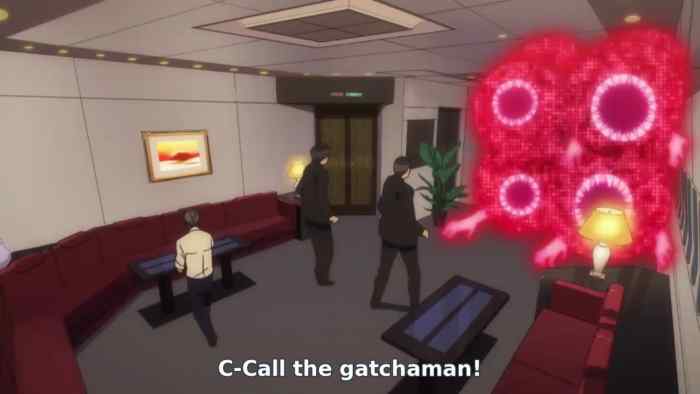
The attacks on individualism consist of the radical actions of VAPE and, more specifically, the unusual words of its leader. In particular, a certain scene stands out. Suzuki discovers the hideout of Rui, and using the power of CROWDS, teleports into his home. Upon arriving, Suzuki commands his red CROWDS to attack Rui, prompting him summon his own blue CROWDS to defend him. To this chain of events, Suzuki comments that “it seems [they] are quite the apes as well.” Suzuki’s comment points to the unconscious facets of human nature: greedy, uncultured, violent, drunk on power, all things which the radical peace activist claims are enhanced via distribution of CROWDS. Suzuki isn’t wrong, and his actions with VAPE serve to illustrate the point. Why should beings who can be described as having such undesirable, irrational traits be granted the immense powers of CROWDS?
Suzuki’s words have a hidden meaning to them, a meaning not immediately discernible in the early parts of the series. Assigning the human race the epithet “apish,” Suzuki also compares us to mere animals, beings that can’t think for themselves. This is made evident when the Kuu-sama appear. Completely dominated by the euphoric and dependable aura exuded by the alien creatures (to be later discussed in some more detail), people easily let themselves be swept along with the emotional ambience of the nation. There’s no need for a dictator or tyrant to force people to do things; the most efficient motivator of behavior is social pressure, and that can be created without an overbearing, despotic leadership.
Why, then, should beasts that are so easily misguided be given the power of CROWDS? The argument against individualism here is that an individual doesn’t hold truly independent will. All the time, we are being molded into the shape society and culture demands us to be. Some things we hold as truth because they are argumenta ad populum, opinions or facts we take as truths simply because everyone concludes they are true, even when they are harmful and inefficient. Customs and traditions also foster and promote thoughtless behavior. At best, these are a nod to the actions of generations past, acknowledgement and respects paid to our ancestors. At worst, they are ignorant and senseless, actions done simply because they’ve always been done this way. Always influenced and swayed by pressure from others and the past, the human race seems to prove Suzuki’s insistence of taking the power of CROWDS out of the hands of the common people is a rational view.
However, not everyone has given up on the miraculous abilities of CROWDS. In particular, Prime Minister Sugayama firmly believes in the potential good that can come out of continued use of the program. It’s interesting to see the logic behind Sugayama’s confidence in CROWDS, and by proxy, the individual. He reasons that society is made up of individuals, and though a group of individuals may form a community, the community is dictated by the actions of the individual, not the other way around. He believes this is true, so much so that he opens up smartphone polls, a simpler and easier way in the digital age for voters to cast their vote on an election or policy change.
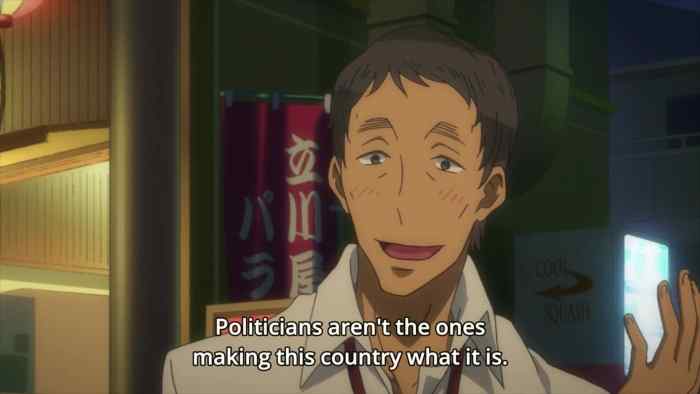
Sugayama’s approach to human nature is evident when he decides to allow smartphone polling to become a legitimate political process. Every person who casts his or her vote via the smartphone has given thought to their decision, and thus, the community moves according to individual decisions. As per his personal philosophy, Sugayama’s confidence in CROWDS is unwavering, so much so that he stakes his position as Prime Minister of Japan on it. Sugayama resigns and announces his candidacy for reelection, stating that whoever the people choose as the next prime minister is entirely up to them, and from here, the thematic message of Gatchaman Crowds insight slightly shifts.
The Power of the Media in the Age of the Internet
As soon as Gelsadra begins her campaign for unity, the thematic core of the series shifts. It’s here that the discussion over the power of media really picks up. At the start of the campaigns, most people were indifferent or apathetic to the politics of re-electing a Prime Minister. Many stated they would vote for the incumbent prime minister out of apathy or indifference. However, a few missteps in communication with the public condemns his fate. The organization of his downfall is almost predictable in today’s politics; political candidates are felled left and right by the momentous and omnipotent hammer of the media. The parallels between the political procession of fictional Japan and the fall of Howard Dean of the 2004 US Democratic race are remarkable. For those unaware, Howard Dean was a Democratic politician campaigning to earn the Democratic nomination to run for Presidency who had gained enough momentum to top the polls. On January 19th, 2004, Dean had just placed third in the Iowa caucus, a disappointing result for the candidate. In an effort to rally his supporters, Dean gave a public address he thought would invigorate his campaign. In his excitement, he let out a rallying call, “Yeah!” but his hoarse throat emitted what is now known as the “Dean Scream.”
Despite being an educated, well-established, and popular candidate, in just over a month, Howard Dean had lost so much support from the general public that he announced his resignation from the race. In the span of 30 days, Dean went from the most likely to win to media laughingstock. According to the Associated press, “cable and broadcast news networks replayed the scream 633 times in the four days following the incident, a number that does not include talk shows and local news broadcasts 1.” It’s absolutely clear that despite understandable circumstances, immense former popularity, and a solid political platform, the blows against Dean dealt by the media sealed his fate.
Why the long tangent about an obscure fact of American politics? Though the scale and circumstances slightly differ, the political race in Gatchaman strongly reflects the impact of the media in politics in an age when the internet is our main source of information consumption. As the internet is always on and ready to deliver information, the smallest bit of news in the right hands can create a disproportionately massive effect. Prime Minister Sugayama should have won the election he proposed. Gelsadra as an alien doesn’t even fulfill the minimum requirements to run for the position, and the other legitimate runners had a minuscule portion of the electoral pie. However, due to the immense popularity of the Millione Show, the accessibility of the internet, and a few farcical errors, Sugayama failed to recapture the throne he willingly gave up.
This brings to light the immense leverage media has in the fight for control over society’s mind and the forces that brought digital journalism to the forefront of information control. With the expanding userbase of the internet and the advent of smartphones, people both in the real world and in Gatchaman have unparalleled access to news. Information constantly streams from portable devices that people carry with them everywhere. But the information has to be gathered, processed, then presented in a simpler format; most people don’t have the time nor feel compelled to take the effort to sift through the oceans of raw information. Here is where modern news and media outlets exert their influence. By becoming the filters of information, they have a near monopoly on the what and how news is brought to public attention.
Kuu-sama and a Regime of Social Pressure
The Kuu-sama are the product of everything that has happened in the series up till the point they appear and, as such, are also the final major topic of discussion. The Kuu-sama are manifestations of people’s emotions and opinions, incarnated by an overflow of Gelsadra’s powers. After repeatedly using his ability of gathering the thoughts, Gelsadra grows noticeably rounder until he vomits some of the thoughts he collected in the past. The regurgitated ideas eventually form the Kuu-sama, strange beings that are uncannily good at reading the mood. Because of this, the Kuu-sama are named (the ‘Kuu’ comes from the Japanese word for atmospherear ‘kuuki’) and immediately accepted by the people as faithful companions that are always there, celebrating with the joyful, comforting the anguished.
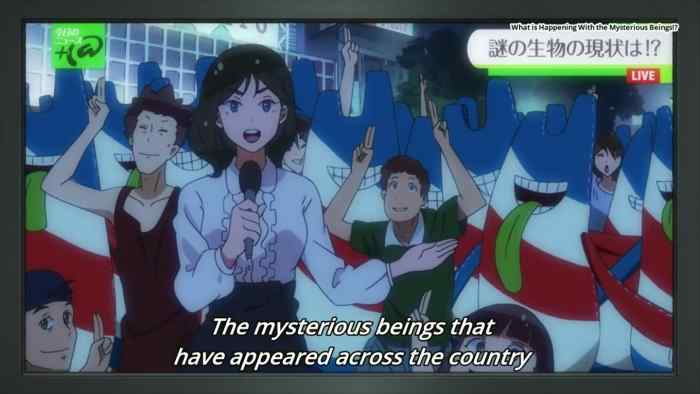
Most citizens incorporate Kuu-sama into their daily lives, treating them as neighbors and close friends. An overwhelming majority support to keep the Kuu-sama around despite their alien status, and Gelsadra finally seems to have finally rid himself of the constant thorn in his side, the miniscule minority that always stopped the progress of complete harmony. However, things quickly start to go awry as the first series of incidents occur. In a social situations in which there is a disagreeing minority, the smaller party get swallowed by the Kuu-sama, literally getting swallowed by the atmosphere.
Though shocked at first, most people are fine with the result. ‘Those who disagree deserve to get eaten because they interfere with the progression of a unified world,’ the majority reasons. Most of the people swallowed were troublemakers or anti-social, but the victims soon encompassed those who disagreed with the majority. People feared to express dissent, and the friendly smiles of the Kuu-sama turn into sneers of suspicion. Through all of this, Gelsadra does nothing; he thinks it is the easiest possible way to achieve peace. As mentioned in a prior section, this is where Rizumu Suzuki’s words from a previous section comes to bear fruit. People are apes because they are unable to think for themselves, always relying on their peers and society to think for them. It turns out that there’s a handy real-world example to help us with the comparison.
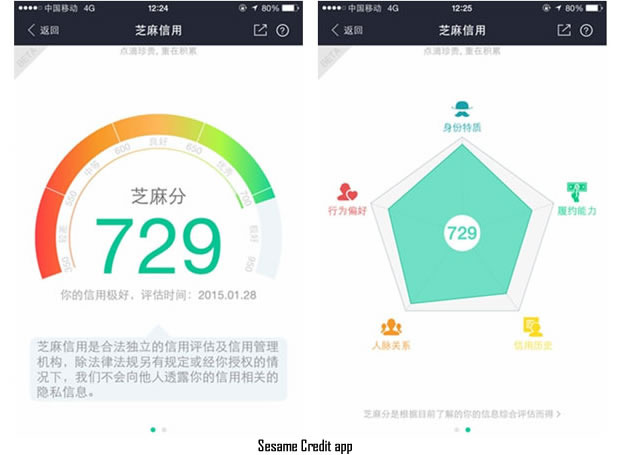
China’s financial credit system is run solely by the People’s Bank of China, but only 300 million out of 1.3 billion people are registered by the institution. 2. Because of this, the vast majority of Chinese citizens are not eligible for a loan by traditional standards and are more willing to save up money than invest or spend. This, along with the general deceleration of the Chinese economy, has prompted the Chinese government in 2014 to give ten private companies the mission of devising a credit score system that will allow those without extensive federal banking history to obtain a credit score. 3 By 2020, China plans to implement a national credit system that is mandatory and will encompass a larger percentage of the population. Of the ten companies, two have been making an ominous splash in the international scene: Tencent and Alibaba.
Tencent Holdings Limited and Alibaba Holdings Group Unlimited are two of the biggest electronic content consumption companies in China. While Alibaba might not be a household name in the Western hemisphere, Tencent owns a portion of major game developers such as Activision Blizzard (Starcraft, Call of Duty) 4 and Epic Games(Gears of War, Unreal) 5 and, as of December 16th, 2015, completely owns Riot Games , known as the developers of the international smash hit League of Legends. 6 Both companies are influential in China, but the one we’ll be focusing on is Tencent. Though both have had negative media outlash in the West, Alibaba is often mistakenly blamed for the characteristics of Tencent’s credit program.
Along with significant holdings in the American game industry, Tencent also is a giant in the Chinese social media scene, having created Weibo (a Chinese alternative to Twitter) and popular messaging apps QQ and WeChat. As a social media giant, Tencent is making use of its online resources and datamining people’s social media to compile a credit score. 7
By itself, it’s pointless to have a bad credit score. A majority of the people in China already don’t have access to federal banks, and those who are openly opposed to the actions of the Chinese government are likely already blacklisted. Instead, these new credit programs utilize positive reinforcement to reward those who have high scores with prizes ranging from not requiring deposits for hotel rooms to VIP passes to Luxembourg. 8
While there’s no explicit mention of the effects of differing government viewpoints, given China’s reputation and history, it’s more than likely that anti-government sentiments will result in a negative impact on one’s credit should they incorporate social media into the credit scheme. In a translated document published by State Council is stated this:
Strengthen sincerity management and education among civil servants. Establish civil servant sincerity dossiers, enter civil servants’ personal credit information concerning reports on events, records of sincerity and cleanliness in government affairs, the results of annual evaluations, acts violating laws, disciplines and contract into their files, and make civil servants’ sincerity records into an important basis for assessment, employment and rewards. Deeply launch education concerning sincerity, abiding by the law and morality among civil servants, strengthen study of legal knowledge and credit knowledge, compile civil servants’ sincerity manuals, strengthen the legal and sincerity consciousness of civil servants, establish a line of civil servant teams that abide by the law and by sincerity, are highly efficient and clean. 9
The goals of the new credit system are terrifying because the they’re cheap, pragmatic, and self-maintaining. Extra Credits describes the potential misuse of the new social credit system well. There’s no longer a need for the government to police the people; brute force and terror tactics have always failed in the past and play no part here. Instead, social pressure will isolate and discourage those who speak out against the leadership. It’s entirely possible that anti-patriotism can lower one’s numbers, and that being associated with a low scorer can bring down your own score. It could mean that a friend’s actions can prevent you from reaching the luxurious benefits that you deserve. Social pressure will selectively breed citizens that fall in line with the government’s words, and all of this is free.
This is another long politico-economic tangent, but the connection here is plain to see. Already, the notion of a private credit score is being replaced by one that insists credit scores are akin to a trophy, something you can proudly show to your neighbors, albeit most of the flaunting has come from users of Alibaba’s program, Sesame Credit. 10Regardless, the optimum social vantage point has been established for the Chinese government to perpetuate the positive outlook on a social credit score system, and it’s a system that the Chinese government can abuse to create a situation in which freedoms are stripped to maintain a political regimes hold over a nation.
Bringing it back to Gatchaman Crowds insight, I’d like to point out Gelsadra’s unrestrained happiness with a situation in which social pressure eliminates a vocal minority. He’s elated because at last, there will be complete harmony throughout the world. Gelsadra brings up the point that there’s no great achievement without some sacrifice, and that the minority have suffered for the greater good. To an extent, this is true in China as well. With a billion people unregistered in the central Chinese banking system, not many people have the access to capital to improve their living conditions and help bolster the stalling Chinese economy, and many don’t have the financial history to secure a loan under the traditional credit system. A new system that measures security via social sincerity might be the key to helping China’s middle class grow into a strong force that carries the Asian superpower’s economy. But is a collectivist regime built on the suppression by social pressure worth the suppression of a minority?
The Conclusion of an Essay and its Focus
Bringing back the whole essay full circle, Gatchaman Crowds insight says no. Individualism and the ability to live how you want is a price too steep to pay for worldwide peace. Humans are foolish creatures, easily swayed by simple and meaningless things. But that’s also the beauty of our species, and the way we differ from each other makes our life sparkly, as Hajime mentions constantly throughout the series.
The Gatchaman sacrifice their comrade and de facto leader, Hajime, in an effort to quell the now extreme demands of the people fueled by the media, the internet, and social pressure. The Gatchaman, revealing Hajime’s selflessness, manage to teach the Japanese to breathe in the opinions and views of the world, but only after sifting through those views and thinking carefully about them should they exhale and speak. And I would like to repeat this advice to you, the readers.
I’ve presented three interrelated topics of discussion. None of them are discussed in the detail they are justified; I’ve only scratched the surface and introduced them. The great thing about Gatchaman Crowds insight is that there are so many other questions to be answered. Is human nature not the problem? Are the tools we used to empower human natures the issue instead? Should media be allowed to continue as a commercial commodity? Is the internet creating a hive mind that directs our every actions (that’s just a theory), even without the power of media outlets? Or maybe, is Gelsadra actually right? Will humanity eventually come to the point where socialism can be enacted? Maybe the main theme of the series is to your liking: how does a collective emotional state affect society? Post any and all discussion topics, in the article or not, in the comments section below.
I focused on the three topics present. Your focus may lie elsewhere. The beauty of Gatchaman Crowds insight is that it will be related to what was talked about here. After all, it’s a philosophical essay, molded into anime form.
2.5 Overlord: Isolation in the Digital Age
What would you do if you were alone in an inescapable virtual world? It’s the question I started the section of Overlord with, but sadly, neither I nor the show delve into it. It’s a question with such significance, especially in an age when interactions behind the screen are becoming ubiquitous. It’s a lot of wasted potential, and I’d like to talk here about how the series could have developed this theme of physical and emotional isolation in a digital surrounding.
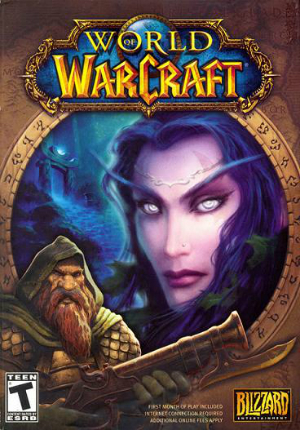
Firstly, a Virtual MMORPG is a perfect setting for discussing such a topic. A VRMMO is the manifestation of the digital world, the epitome of the growing influence of the internet and electronic communication. Without complete integration of the populace into the internet, a VRMMO cannot exist. Furthermore, any MMO by definition is a social experience — the acronym stands for ‘massively multiplayer online.’ Many games emphasize skill, fun, or strategic thinking, and while MMO’s don’t necessarily exclude these elements, they’re certainly not the priority. The best MMO’s reward players for interacting with other players: EVE Online with its ship-building process; World of Warcraft and its intricate trade and guild system; Everquest with its engaging player co-op options. This is significant because MMO’s like to mimic the real world in how it deals with a player’s social ability. Making a legendary weapon is a lot easier when you’re able to rely on others to help you get the materials you need in the same way that it’s much easier to buy bread, lettuce, tomatoes, and bacon to make a sandwich than it is to raise and grow the ingredients yourself.
The character is a bit plain, but his emotional makeup is exactly needed for a discussion of this type. Whoever the person is behind Momonga, he’s a normal guy with incredible dedication to the game. He is one of the many immersed in once of the many services of the internet. Keep in mind that the discussion here isn’t “What would a practical person do in the face of digital isolation?” or “How would the emotionally strong react given this situation?” The exploration should be around what normal people would do in the face of solitude in an electronic ocean. Despite the ease of staying connected to people, how does a normal person face physical seclusion?
There would be a couple ways to explore this, none of which manifest (because anime roleplay reasons). Where’s the initial panic and desperation that was depicted so well in Sword Art Online? Where’s the progress of Momonga’s emotional state, tracked well in other similar series such as Log Horizon? It’s not there, and if nothing starts, nothing can continue. But, there are many ways to develop the running theme in ways that are and aren’t present in the show, and while the former questions might be the most basic way to bring about discussion, there are other paths available to the series.
One of the more prominent ones I thought could have been explored without changing the plot or characters would be the route of exploring humanity, that is, what makes a human a person? This scenario takes into account the fact that Momnga is largely unaffected by his sudden change in state of living. He’s clearly aware of the fact that he’s not in immediate contact with a real human, and yet his mental state is sound. One explanation seems to be the human interaction with the inhabitants of the new world. They act in human ways, living as people, laughing as people, crying as people. Perhaps they are people? Momonga certainly still believes that he’s in a game, one set in a new world perhaps, but a game nonetheless. Subconsciously, he recognizes the inhabitants of the new world as NPCs, creations of artificial intelligence, though he may never explicitly say so. Even in the show’s brief humorous moments, he refers to the guardians of the guild halls as NPCs, thoroughly surprised they act the way they do despite being NPCs.
At the same time, he treats the denizens of the world as humans, saving them when they need saving, serving justice when justice is required, and interacting with other adventurers as though they were real people. This begs the question of whether Momonga is being saved by the actions and attitudes he has towards those around him. Is AI sufficiently intelligent and human enough to satisfy our need for social behavior? How far down the spectrum of human-like cognition can we make do with as a substitute for real human interaction? When AI get sophisticated enough to have conversation with, will interpersonal relationships dwindle, and maybe cease?
There’s another point that could be addressed by the same scenario. Momonga claims that there are times when his mind compels him to think or act differently than he normally would have. These instances mostly involve “softer” emotions of things such as sadness. He thinks to himself that these inclinations are a product of the game or of the body he inhabits in the game, but what if this weren’t the case? What if something akin to the Stanford Prison experiment were taking place instead? It’s a fun concept to think about. In this case, it’s not necessarily the AI’s humanity acting in lieu of real person to person communication that’s saving Momonga, but his ability to overwrite his subconscious thoughts of these NPCs being AI. He’s not being saved; he’s saving himself by resorting to denying the information he knows must be true, but denying it nonetheless because he would go insane from loneliness did he not.

This brings up a relevant point concerning the advent of the digital age. We already know that people behind the screen act differently behind the screen through a variety of studies. 11 12 How would people act in a world completely taken over by artificial intelligence and the internet? Would Momonga’s psychological reaction be a commonplace occurrence? These are all things that can be addressed in the series that haven’t really been brought up but could have been given the current state of the characters and the plot, and it’s an opportunity missed by the writers.
Given the premise of the series, I think there are many more problems, statements, and questions to be posed, things that are and aren’t addressed by the series in its current state. It’s a shame that the author didn’t have the foresight to set up Overlord to deal with them, but what the author failed to do isn’t up to the fans. We don’t, after all, decide what an author does. Is there anything that you’d like to share? Continue the discussion in the comments section.
It’s really the end!
You’re through! You’re now decently educated on nearly all of the series shown in the season of Summer 2015. Hopefully, you gained something out of the analysis section and have something to say as well. Thank you for reading through this guide, and until next time, I wish you an exciting and engaging anime experience.
Works Cited
- Loyola Phoenix, “The scream that left us blind”, 2/11/04. Retrieved November 27, 2006. ↩
- http://www.bloomberg.com/news/articles/2015-07-02/china-credit-scores-come-to-a-debt-leery-culture ↩
- http://www.ft.com/intl/cms/s/0/34e77fe8-a6a3-11e4-9bd3-00144feab7de.html#axzz3uZ0z7YYw ↩
- http://www.engadget.com/2013/07/26/activision-vivendi-split-for-8-billion/ ↩
- http://www.engadget.com/2013/03/21/tencent-sunk-330-million-into-epic-games-owns-nearly-half-of-s/ ↩
- http://www.thescoreesports.com/lol/news/5378 ↩
- http://www.chinadaily.com.cn/business/tech/2015-08/08/content_21535587.htm ↩
- http://qz.com/519737/all-chinese-citizens-now-have-a-score-based-on-how-well-we-live-and-mine-sucks/ ↩
- https://chinacopyrightandmedia.wordpress.com/2014/06/14/planning-outline-for-the-construction-of-a-social-credit-system-2014-2020/ ↩
- https://www.techinasia.com/china-citizen-scores-credit-system-orwellian ↩
- Silcox, Mark, and John Cogburn. “Philosophy Through Video Games 1st Edition.” Philosophy Through Video Games: Jon Cogburn, Mark Silcox: 9780415988582: Amazon.com: Books. Routledge, n.d. Web. 11 Oct. 2015 ↩
- Yi, Nocholas. “The Psychology of Massively Multi-User Online Role-Playing Games: Motivations, Emotional Investment, Relationships And Problematic Usage.” (n.d.): n. pag. Nickyee.com. 2006. Web. ↩
What do you think? Leave a comment.




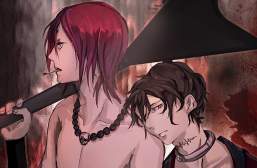
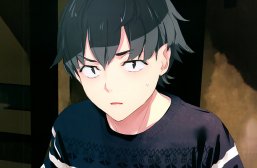
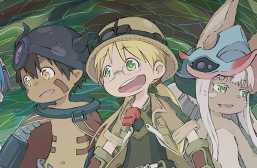
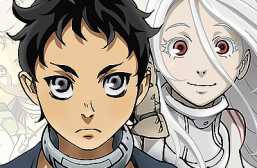
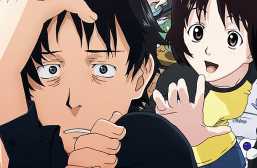
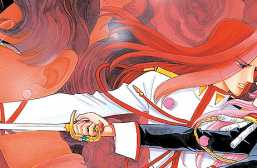
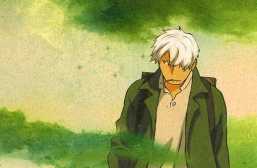
When I saw the title “Charlotte”, I immediately thought of a Samurai Shodown anime (not the rubbish one from years ago – a new, better, anime). Ah well…
The only interesting shows in this list are Gangsta. The rest… bah. Not a very exciting season.
Already watched and loved Dragon Ball Super, Gangsta, and Charlotte. Rampo Kitan is up next for me. Then Prison School later this week.
I wish crunchyroll got a few more than they did like that prison school. It sounds interesting.
Glad to see this finally got published! Wintertime isn’t a bad time for anime either!
This is honestly a great resource. Seriously. I think I might be coming back to this post whenever I’m in search of a new anime.
Awesome work on a very comprehensive anime guide. I can tell a lot of thought went into it.
Perrrrfect
I think the winter time is the perfect time to publish this – everyone wants to stay indoors and what better way to entertain yourself than with some anime? Great job!
Thank goodness – another reviewer that understands how to spread the word about Gakkou Gurashi. I remember Dodger doing the same thing on her Youtube channel – recommending it without saying anything at all. It’s a testament to the show’s integrity that almost every detail of it you could share is an immersion-breaking spoiler.
Some your comments on the show are however incredibly uninformed.
To say ’emotions of terror and panic are hard to empathize with when the characters looks like they’re six years old’ is just ludicrous. On the contrary, vulnerability of character /heightens/ the extent to which the viewer can appreciate terror. The clash between innocence in youth and gritty reality is rife with potential. This is why Coraline was such a success, for instance. You certainly make it clear that you didn’t engage with the characters yourself through that clash, but trying to spin that into a general philosophy is a step too far.
It’s also strange that you contradict yourself, praising (only) the hook in the ‘good’ section but then claiming the series doesn’t have ‘seriousness from the get-go’. Did you not take Yuki’s mental condition seriously? There is no room to take her condition as a ‘novelty’ – I find saying that insulting to people who suffer themselves from a condition like hers. Seriously insulting.
I’d also like to hear what these ‘major plotholes’ are, as I followed the show weekly on my blog and found none. It sounds like you just haven’t paid enough attention. To think ‘her mental condition’ is ‘left unexplained’, you must have missed the frequently repeated evidence that she has a post traumatic stress disorder caused by the death of Megu-nee. That’s pretty much the subject matter of the entire story, and what whole episodes are used to explain or deal with. I’m lacking the words to describe how inexplicable I find your ignorance of that.
There are many other aspects of your review that I disagree with, but the above are simply things that have no ground to stand on regardless of my personal opinion of the show.
I also disagree that Sore ga Seiyuu is limited to an audience interested in the subject matter, and that it is about ‘informing rather than entertaining’. Like Shirobako, the heart of the show is about the struggle of general artistry/youth, which most viewers can relate to, and I connected with Futaba not through interest in what the show at times acts as a ‘documentary’ for, but because of her unique sense of determination, which could have been applied to many other contexts. I haven’t remembered much of the ‘information’ of the show, but the characters have really stuck to me. The show was the season’s dark horse, and I don’t think you’re giving it the publicity it deserves.
Your note that ‘it’s poor taste to criticize a slice-of-life series for not having a good plot’ reinforces my impression that you’re not the kind of anime viewer who can give a useful review of slice-of-life shows. This guide was a fun read, and the effort is worthwhile, but many of your criticisms remind me why I don’t find having these lists written by only one person to be beneficial.
Wagnaria !!!, Jitsu Wa and Monster Musume were my picks for this season; I just want some good comedy, and I’m a fan of the Jitsu Wa manga.
Everything else looks quite solid, but the above shows got my free time.
Gangsta looks…okay…everything else looks like hot moe harem trash.
I have been looking forward to Monster Musume no Iru Nichijou for a while now!
The ecchi part of Prison School doesn’t do it for me since I don’t like the designs of the girls, nor am I a masochist. But damn, this show is fucking FUNNY! The absurdity of the situations and the reactions of the characters are priceless! The faces people make are at a Gintama level of hilarious!
ANIME, WHY ARE YOU DOING THIS TO ME? I CAN’T WATCH ALL OF YOU.
It’s been a while since the last anime I saw. I’m picking up the new Dragon Ball for sure!
Me too. I don’t know what happened to me. I mean, I’ve probably missed a lot of great animes this past two years, but I grew tired of the same formulas, settings and similar synopsis. Just look at the ones from this post.
God Eater looks pretty. So does Rokka.
I really recommend Akagami to anyone who like Shoujou manga/anime. Shirayuki is one of my favorite Shoujou heroines. She is a strong will and does not always wait for a knight in the shining armour to come and save her from troubles. The fact that the show itself is a twist of Snowwhite fairly tale is a bit plus too.
Charlotte surprised me. I liked it a lot more than I thought I would.
Best. Guide. Ever.
Rokka: Brave of the Six Flowers is particularly distinct being set in a fictional Meso-America with all the macuahuitls and serpent bird gods that you can handle. The animation was solid and the main characters are young adults, not child-soldiers, so that’s nice.
There’s still a few shows I’m planning on checking out, but so far Rokka and Gangsta. are my two pics for being the ones I’ll probably end up liking the most this season.
It’s nice to have an adult protagonist in GATE.
Snow White with the Red Hair filled the Yona shaped hole in my heart. This type of shoujo is my favorite genre of manga/anime. It didn’t grab me as much as Yona did the first episode, but I still loved it.
Could barely get through the first episode of GANGSTA.
Is it just my imagination, or did Funimation get all the “big”, most anticipated anime this season? I’ve been ignoring their elite program for a while but right now I’m hardly getting any use out of my Crunchyroll account.
Charlotte! Interesting and funny but it is made by key so a tragedy is bound to happen..
I love how much work was put into this. It shows how in-depth you were looking at the season and how well cultivated your experience in this season has become. I can tell you had to do some serious research for this. Plus I like how you added to videos in for more of a visual effect instead of a visual key.
I don’t see anything that sparks my interest, such a shame. I mean, I’ll be watching DBS eventually because of course. My husband and I are together because of DBZ, we met when we were 12 in a the IRC channel for planetnamek.com.
Gangsta looks promise. I am largely giving it a shot due to it having a cast of not teenagers, which is always a nice breath of fresh air in anime, and also because Manglobe. I still give Manglobe the benefit of the doubt, since they made two of the best anime of the last 10+ years (Samurai Champloo and Ergo Proxy, of course).
I didn’t know the Gate manga before and it turned out to be a big surprise for me. The first ep. was really solid and I really like the idea of reality vs. fantasy.
Loved Rokka. The animation is great, I’m enjoying the Meso-American setting and the story is interesting.
From the stuff i have watched
Gangsta.
Interesting setting, interesting characters, great music, fantastic op and ed, among my favorites of the season
Tried watching DBS. Fansubs are still horrible, and the japanese dub is still weird.
I watched it at animeshow.tv and didn’t find the subs to be too odd. The dub however, it’s weird when you only know them in English
Wow. This is an extensive list! Lots of great picks on this. I really liked the new Fate Stay Night a lot. So beautiful and a great story
I dropped Chaos Dragon about five minutes in. I usually at least finish the episode of something, but everything about it felt bad from almost the get go. Weird stilted CG in the opening, pretty bland designs and mediocre animation, can’t really comment on the story. Not even the promise of a catgirl could save this one for me.
Watched Everyday Life with Monster Girls last night with my husband based solely on the name of the first episode. Despite watching with our mouths gaping open half the time, I was surprised I enjoyed it as much as I did. Normally I hate these types of shows but the characters were actually likeable and not over the top annoying.
God Eater, God Eater, God Eater!I love it, even if I think the shading style is weird.
I’ve been recently trying to get into Anime, but completely unsure what to watch, so I am going to bookmark this article!
my recomendations to begin watching anime:
1. figure out the genre and styles if anime you like. note that Yes, there is a difference between “genre” and “style”. style is more like how the anime feels while genre is more overarching.
2. go watch some of the classics. Classics are ussually well made and showcase what each genre has to offer while still being extremely unique. Not to mention, if you ever decide to talk to someone about anime, they will probably mention some of the classics. I’m not saying go watch every episode of dragon ball or any of the other rediculously long anime series out there, (but if they hook you, go for it) I’m saying go sample what anime in its highest form looks, sounds, and feels like.
3. look deeper. once you have watched enough, you will probably begin noticing the smaller tropes and tricks in individual animes that make some feel unique and others blend together. find out which of these YOU like best and expand on step one to find what you like. this could be a specific niche of anime or a much broader spectrum of animes.
best of luck and hope this wasn’t to much.
Really enjoyed Gate. Mostly because it featured an Apache copter taking out a dragon while orcs were mowed down by tanks and machine guns. Why this entertains me so much, I don’t know.
Only one anime seems interesting to me, simply because I was a fan of the manga back in the days when I was reading Shonen Sunday.
Many of these, going solely by the overview here, seem too similar to earlier shows/manga or just isn’t interesting to me.
I highly recommend the recent ongoing series of One-Punch Man. It is a parody of many action anime that features ridiculously overpowered characters. The main protagonist Saitama has power to defeat anyone in one punch, as the title suggest. Sounds like a stupid concept on paper, but in fact it proves to be hugely entertaining on paper (the manga). The anime adaptation is one of the best anime I’ve seen that came up this year. Despite being a comedy, the animations of the fight scenes in this show is top-notched. Definitely worth checking out.
I’m watching EVERYTHING.
Well not every thing. I won’t be watching…
Gatchaman Crowds Insight(just started to watching season 1)
Glad to see some Manhua adaptations this season. Nice to see the industry expanding to different cultures.
Wow, compared to last year, not much… maybe I’m getting older and I don’t really like ecchi that soon will be in every anime.
God Eater, best anime <3
Can’t wait to see:
-Durarara!!x2 Ten
-God Eater
-Overlord
This article is so good. I may or may not agree with everything, but you put so much effort into it I’m awestruck.
I hope, if you have the time, keep doing this for every season with shows that you wish to acknowledge because I know people would appreciate a serious overview of things they chose to skip over each season.
Addendum, Charlotte was so frustrating.
Working! did end up tying all the loose ends and the protagonist does does start a relationship with Inami.